Queens Borough in New York City is known as “The World’s Borough” for a reason: what happens on Roosevelt Avenue has ripple effects near and far.
In this vibrant borough there is a street called Roosevelt Avenue that cuts a cross-section through some of the most ethnically diverse neighborhoods on Earth. Spanish, Bengali, Punjabi, Mixtec, Seke, and Kuranko are among the hundreds of languages spoken here. Nepalese dumplings and Korean noodles, Mexican tortas and Colombian empanadas, Thai curries and spicy South Indian vindaloos are just some of the many food choices.
Passing from one block to the next—through neighborhoods including Elmhurst, Corona, and Jackson Heights—can feel like crossing continents. Plazas and parks are crowded with vendors selling tamales, atole, and large-kernel corn. Tibetan Buddhists, fluent in the Indigenous languages of the Himalayas, walk to worship in their red-and-orange robes. Bangladeshi curbside markets teem with overflowing crates of ginger, garlic and humongous jackfruits, picked out by people wearing saris and shalwar kameez.
Growing up in New York, my own family would come to Queens to watch World Cup matches in South American cafés, just as our abuelos would visit their trusted Argentine butcher for fresh cuts of meat, and our Bukharan Jewish neighbors would come to pray, and our Indian family friends would come shopping for amulets and syrup-drizzled sweets for celebrations, all within this same 10-square-mile stretch of city.
Roosevelt Avenue is a pulsing artery of commerce and life. The road itself is chaotic, dark, and loud. You know you’re on Roosevelt because the elevated 7 train runs overhead, the tracks draping it in slitted shadows, and when the 7 train thunders past, for a moment, the frenzied thoroughfare is consumed: older women look up from their pushcarts; chatting friends fall silent mid-speak; and children cover their ears.
Above the storefronts, at the level of the train, are smaller brick offices with signs that reveal the more pressing needs of such a migrant-rich community: “Sherpa Employment Agency,” “Construction Safety Training,” “Irma Travel: Send Money and Shipments to Lima and Provinces.” Taped to the metal pilings and lampposts are hand-written listings with tear-off phone numbers, mainly in Spanish, advertising “rooms for rent,” “employment needed,” and “help wanted.”
Road signs welcome drivers entering Queens to “The World’s Borough.” But there is another phrase that might be more apt: “Queens, Center of the World.” That’s because what happens on these streets has ripple effects near and far, sometimes as far as on the other side of the globe—and what happens on the other side of the globe also certainly influences who ends up here. Perhaps at no other point has this been more urgently felt than during the fallout from the COVID-19 pandemic.
In the spring of 2020, the virus ravaged this part of the city. Most people who live here are essential workers who cannot work from home—restaurant cooks, delivery workers, cab drivers, construction builders—and many live in overcrowded quarters, so the disease spread precipitously. Elmhurst Hospital, which serves this community, was declared the “epicenter of the epicenter” for the initial outbreak in the U.S.
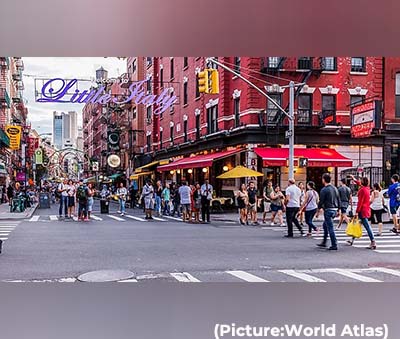 In New York, such a rapid and large-scale loss of life meant that the city’s engine sputtered to an even more devastating halt; in other places, like Mexico and Ecuador, Bangladesh and Nepal, it meant that many families could no longer rely on support from relatives in Queens who were suddenly out of work, or worse. Joblessness and hunger skyrocketed, residents just barely getting by. And yet only for a very short while did walking Roosevelt and its surrounding streets have the same eerie, empty feel as in the rest of the city. Its communities and micro-economies, heavily reliant on in-person interactions, cannot afford to stay still.
In New York, such a rapid and large-scale loss of life meant that the city’s engine sputtered to an even more devastating halt; in other places, like Mexico and Ecuador, Bangladesh and Nepal, it meant that many families could no longer rely on support from relatives in Queens who were suddenly out of work, or worse. Joblessness and hunger skyrocketed, residents just barely getting by. And yet only for a very short while did walking Roosevelt and its surrounding streets have the same eerie, empty feel as in the rest of the city. Its communities and micro-economies, heavily reliant on in-person interactions, cannot afford to stay still.
“The people who come over, they come to help their family,” says Sanwar Shamal, of Bengali Money Transfer in Jackson Heights.
Snippets of South Asia
Around the 74th Street subway station, the neighborhood is heavily South Asian—mostly people of Bangladeshi, Indian, and Nepalese origin. Bengali-speaking men wearing skullcaps sell plush prayer rugs, headscarves, and gold-plated Islamic iconography from milk crates on the sidewalks, cigarette smoke pouring out of their mouths as they talk. Mannequins showcase bright-colored salwars and chaniya cholis through tall glass windows, and restaurants serve curries with rice and water in silver bowls and cold metal cups.
Seemingly everywhere in Roosevelt’s path, there is a heightened sense of the “old country”—of memories that haven’t faded over long stretches of distance and time. You feel it in the money-transfer and international courier stores along Diversity Plaza, where people line up patiently to send remittances and packages to relatives back home, relatives they haven’t seen in years and might not ever see again. You feel it on the weekends, when families drive in from all over to shop for groceries at Patel Brothers, or to eat at Samudra or Dera or the famous Jackson Diner. You feel it at the sweet shops, where grandfathers wearing tweed suits and large wristwatches take their smiling grandchildren for treats.
And you certainly feel it when you step into the United Sherpa Association, a former Lutheran Church that in 1996 was converted into a Tibetan Buddhist temple and community center now serving more than 12,000 Himalayan Sherpas, the largest population living outside Nepal. People come here to pray and to drink salty yak-butter tea poured from tall thermoses into bowls of blue-and-white china. In pre-pandemic times—according to Tshering Sherpa, the president of the association—nearly 100 people would fill two floors in this temple to worship. “You could hear the chanting from Broadway,” she says, beaming.
“Our seniors established this United Sherpa Association,” says Temba Sherpa, the group’s vice president, “to protect and maintain our identity.” The Sherpa are a Tibetan ethnic group who for hundreds of years have made their livelihoods in the Himalayas, raising yaks and high-altitude crops in the remote mountains. Practically no one knows the Himalayas better than the Sherpa, and in recent years they’ve also become synonymous with their work as climbing guides and porters on Mount Everest.
“We got our identity and economic benefit from mountaineering,” says Ang Tshering Sherpa, himself a former trekking guide. “But there’s not much of an alternative if you aren’t educated.”
Climbing is often a perilous endeavor for the Sherpa, especially with little in the way of formalized protections from the turbulent Nepalese government. “Going to the mountains, it’s like going to war,” Ang Tshering says. “You don’t know if you’ll come back.” Many hundreds of Sherpa people have died or been seriously disabled on climbs over the years. “Once a Sherpa gets in a kind of accident, the family gets very little, they don’t have a safety net,” Ang Tshering adds.
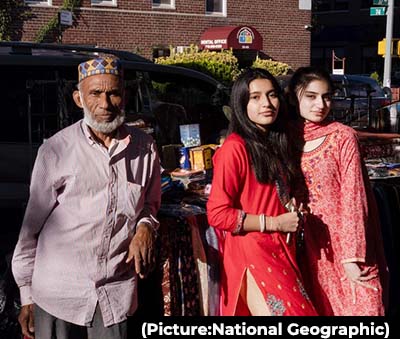 Since the 1990s, and especially after major climbing disasters on Everest, Sherpa have left Nepal in large numbers. Many have come to the area around Roosevelt Avenue, where they often work as taxi drivers, or restaurant cooks and supermarket employees. The United Sherpa Association is a central meeting point of worship and community—where people chant and pray, gather for meals of dhal and root-vegetable stews, and share opportunities for work or study.
Since the 1990s, and especially after major climbing disasters on Everest, Sherpa have left Nepal in large numbers. Many have come to the area around Roosevelt Avenue, where they often work as taxi drivers, or restaurant cooks and supermarket employees. The United Sherpa Association is a central meeting point of worship and community—where people chant and pray, gather for meals of dhal and root-vegetable stews, and share opportunities for work or study.
There are also classes to teach the Sherpa language and traditions to new generations born in the U.S. Shortly after the pandemic began, the association opened a food pantry—available not only to Sherpas but to anyone—and every Tuesday since then, people have lined up in need. And the Sherpas haven’t stopped advocating for their family members back in Nepal, either: for better educational and economic opportunities, and for improved safety infrastructure for climbing guides and porters, especially as recent tourism downturns and pandemic outbreaks have further devastated the country.
“Most of the Sherpa over here, their families are still in Nepal,” says Pasang Sherpa, president of the US-Nepal Climbers Association, a Queens-based nonprofit. “We know exactly who needs help.”
‘La Roosevelt’
Down the road, the sound of spoken Spanish envelops either side of what’s known as ‘La Roosevelt.’ In Jackson Heights there is a block nicknamed ‘Calle Colombia’ (Colombia Street)—where vendors slice cold coconuts with machetes, and tall stalks of sugarcane disappear into juicers for the sweet drink called guarapo. Further east are standing-room-only taquerias, stores bursting with knock-off soccer jerseys, and electronics dealers and barber shops with hawkers outside telling passersby to come in, just for a minute, just to take a look.
On 80th Street, just south of Roosevelt in Elmhurst, Barco de Papel (Paper Boat) stands as the sole Spanish-language bookstore left in New York City. One of the owners is an older Cuban man named Ramón Caraballo who can usually be found there smoking a cigar. He speaks softly and sparingly. “I am just a man who opens up a bookstore in the morning and closes it at night,” Caraballo said when he first introduced himself. “That is all.”
The building is small, just one room, but it is filled from floor to ceiling with a large selection of some of Latin America’s finest writers—Jorge Luis Borges, Gabriel García Márquez, Isabel Allende—as well as lesser-known staff favorites. It is so stuffed with books only its keepers know where anything is to be found.
Caraballo is one of those keepers. Before he co-founded Barco de Papel in 2003, he sold books from a street cart around the corner. “All my life I’ve dedicated myself to literature,” he says. When he opened the nonprofit store—around the same time that Amazon and rising rents began to spell the demise of independent bookstores, especially Spanish-language ones, across the U.S.—it quickly became a community treasure.
Many customers come to Barco de Papel hoping to rebuild the libraries they left behind when they migrated. “They bring their kids, too,” says Paula Ortiz, a high school teacher from Colombia who co-founded the store. “They can’t take them to their countries, so they bring them here.” Others will gather for tertulias—discussions about literature and current events—and live readings.
But Barco de Papel has also become a hub for information. Since the pandemic, many customers leave with information on vaccines, testing, or treatment. New migrants seek out guidance on how to start a small business or learn English. Children whose parents can’t afford to buy another book benefit from book exchanges.
“We have to constantly change with the community, without losing our essence,” Ortiz says. “We owe ourselves to them.”
Corona Plaza
One afternoon in Barco de Papel, I found Caraballo and two helpers unwrapping a large painting that they were planning to put up in a nearby underpass, part of a public art installation in homage to the neighborhood. This one was a bright-colored portrait of a Latina street vendor flanked by a food truck and some ears of large-kernel corn.
Street vending has long been woven into the fabric of Queens, where on the sidewalks you can buy just about anything. In largely Chinese and Korean neighborhoods like Flushing, vendors pull steaming dumplings and salted duck eggs out of steel tubs; plastic bins offer spiced watermelon seeds, eyebrow beans, and goji berry soup. Along Roosevelt, Bangladeshis and Afghans peddling religious items cross paths with Spanish-speaking vendors who sell food and drink, small metal lockets and neon construction vests, disposable masks, rat poison, smartphone cases, and flowered hanging plants.
Some have been selling for years. Many others have only recently begun, after losing their jobs because of the pandemic-induced economic crisis. Pop-up stands of folding tables and tents have appeared (and expanded) on much-transited corners. People walk past with strollers, pulling back the top to reveal not children but candies, popsicles, and sandwiches. Women weave their way through traffic carrying months-old babies in slings on their backs, selling sliced fruit to drivers at red lights.
“Vending has always been big along Roosevelt, especially in Jackson Heights and Corona, but even more so now, because so many people have lost their income, are facing eviction, and have no safety net,” says Carina Kaufman-Gutierrez, deputy director of The Street Vendor Project, a nonprofit that works with street-sellers across New York City. “Every type of relief that came out during the pandemic excluded undocumented folks. And that hit the area so especially hard.”
The Street Vendor Project estimates that during the pandemic, the number of vendors in Corona Plaza, along Roosevelt Avenue at 103rd Street, rose nearly fourfold, from 20-30 people to more than 100. They come prepared for the elements—with tents, tarps, umbrellas and plastic garbage bags—and work through the rain, snow, sun, and cold.
“We used to live in the mountains, my family,” says María Lucrecia Armira, 44, who migrated to Queens in 2019 from a small village in the department of Suchitepéquez, Guatemala. She has had to adjust to spending nearly every waking hour in the smoky heat of a grill stand, selling meat skewers on the loudest corner of the Plaza. Armira arrived two years ago with her 14-year-old son, who enrolled in the local public school; when the pandemic began a short time later, he dropped out and started working full-time selling raspados (shaved ice) and slushies.
“On the one hand I was nervous about the virus,” Armira says. “On the other hand, we were locked down and couldn’t work.” Sharing a single bedroom with her son in an apartment filled with other families, she tries to send $500 per month—or whatever she can—to her two other children, whom she had to leave behind in Guatemala. “Many people count on what we send from here.”
Street vendors now face opposition from brick-and-mortar business owners frustrated with the sudden boom in new and seemingly unlimited competition. In recent months, the city has stepped up its enforcement of street-vending laws, ticketing and removing those without a permit. There are more than 20,000 vendors estimated to be working in the city, and just a small fraction of permits, leading to price-gauging, according to labor activists.
One afternoon on Corona Plaza, the presence of two New York City inspectors sent many vendors scurrying. There were fewer produce-sellers on the sidewalk, food trucks were shuttered, and shopping carts stood empty, piled atop each other beneath the train tracks.
Ana Maldonado stood nervously in the shadows—across the street from her usual spot on the plaza, where for more than 15 years she’s sold tamales and rice pudding and syrupy Mexican-style hot chocolate from a cart of metal vats and orange Gatorade thermoses.
“My customers know me, they know where to find me,” she says, looking out for inspectors from the stairs to the train. The inspectors had warned her to leave, or risk an expensive fine and all of her merchandise being tossed to the trash. “They’re in the middle of the plaza. If they catch me, I’m finished.”
Originally from a small mountain town in Guerrero, Mexico—where, in the green hills, steam rises from rivers swelled with rain—now she wakes up each morning at 4 a.m. and prepares the day’s food for sale on Roosevelt, not returning home until she’s sold everything. Her husband spent 28 days in the hospital with COVID-19 at the start of 2020 and nearly died; he has been unemployed since. “All that my family has, everything comes from this,” Maldonado says. “I work hard to feed them, whatever it takes.”
Queens Globe
As Roosevelt Avenue nears the end of its eastward course, it’s fitting that it passes by the famous Unisphere, the Queens Globe built for the 1964 World’s Fair, that has since become a symbol of this area’s epic cultural diversity. Here in Flushing Meadows-Corona Park, the hustling chaos of Roosevelt Avenue abates, if only for a moment, and the world’s borough comes outside to decompress.
In springtime, families take pictures at golden hour in their best sunshine saris, their favorite skirts and collared shirts in front of an explosion of color: the cornelian cherries, the flowering pears, the forsythia and the redbuds in full bloom. Two years after the onset of the pandemic, despite all the challenges the coronavirus has left behind, there are signs of renewal, too—of soccer games returning to dusty fields with goals carried on backs and bicycles; of misting fountains, and the smell of new grass; of the sound of Mister Softee trucks offering ice cream to children with outstretched arms.
I have often thought about what it means to be American on my walks along Roosevelt—what it means to be the product of so many different stories and struggles and heritages that have led us to one singular, raucous mix of a place. In this country that so deeply strives for assimilation, there is often pressure to distill identities, to make them more palatable for others looking on.
But what is both so special and so hard about Queens is that assimilation does not come easy.
I think about this with every scene that crosses my gaze, with every encounter and conversation—whether in a bookstore or a temple, on the 7 train or on a soccer field in the park. I think about the many definitions of “American” when my own family, a blend of cultures shaped by migrations forced and voluntary, ventures out to this neighborhood for tastes of a past that continues to mark our future here. As parents look for fair and just opportunities to raise their children in the U.S., to learn English, to find work, and to support their families abroad, that sense of the ‘old country’ is unlikely to fade from Roosevelt Avenue, so long as people keep migrating to neighborhoods like this one.
I thought about that when I first met Maldonado, the undocumented street vendor who left Mexico two decades ago and cannot return without risk of not being able to get back into the U.S. I told her that I’d recently been there and asked her what part of the country she was from. Instead of answering right away she touched my wrist with her hands and looked into my eyes. “Cómo está?” she asked about her homeland. “How is it?”

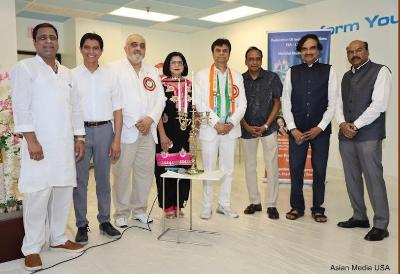 The Lamp Lighting ceremony was performed by the dignitaries, Sunil Shah, Hitesh Gandhi, Dr Reddy, Dr Murthy, Ajeet Singh, Keerthi Revoori, Vinod Gautam, along with the sacred chanting of the auspicious Sanskrit hymns & mantras by Anu Malhotra, praying for the peace, good health and wellbeing of this entire world.
The Lamp Lighting ceremony was performed by the dignitaries, Sunil Shah, Hitesh Gandhi, Dr Reddy, Dr Murthy, Ajeet Singh, Keerthi Revoori, Vinod Gautam, along with the sacred chanting of the auspicious Sanskrit hymns & mantras by Anu Malhotra, praying for the peace, good health and wellbeing of this entire world.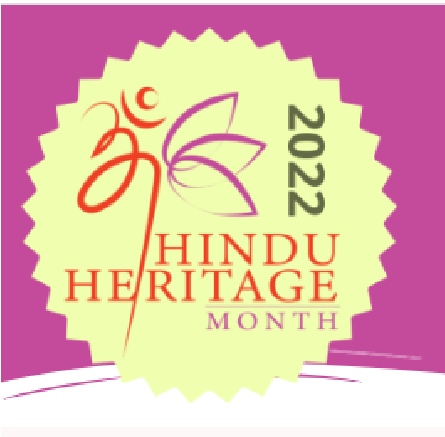 Echoing Bansal’s sentiments, Amitabh Mittal, General Secretary, World Hindu Council of America said, “I encourage our brothers and sisters in Dharma to spread the message of Hindu Heritage Month around the world.”
Echoing Bansal’s sentiments, Amitabh Mittal, General Secretary, World Hindu Council of America said, “I encourage our brothers and sisters in Dharma to spread the message of Hindu Heritage Month around the world.” Organizers of the event say that the idea of a neighborhood Eid festival came about last year to bring the Muslim community, of the White Eagle neighborhood, together with its non-Muslim neighbors after COVID. One of the golden rules in Islam is to love your neighbor as you love yourself. The organizers wanted their non-Muslim neighbors to see who their Muslims neighbors were, share in their celebration and clarify a lot of misconceptions people have about Islam and Muslims.
Organizers of the event say that the idea of a neighborhood Eid festival came about last year to bring the Muslim community, of the White Eagle neighborhood, together with its non-Muslim neighbors after COVID. One of the golden rules in Islam is to love your neighbor as you love yourself. The organizers wanted their non-Muslim neighbors to see who their Muslims neighbors were, share in their celebration and clarify a lot of misconceptions people have about Islam and Muslims. 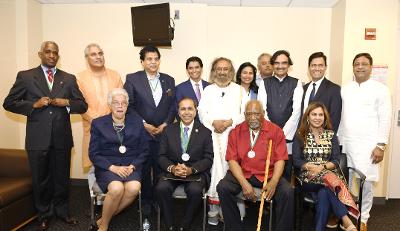 Amidst the series of remarks, State Representative Jim Durkin (R,82nd District) said that he would table a resolution on the floor of the Illinois General Assembly to declare June 26th as the World Peace Day and celebrate its observance in the State of Illinois every year – which elicited sustained applause. Mayor Lori Lightfoot also sent a proclamation to the event, which was read by Alderman David Moore in which she declared June 26 each year to be “I Stand for Peace” Day.
Amidst the series of remarks, State Representative Jim Durkin (R,82nd District) said that he would table a resolution on the floor of the Illinois General Assembly to declare June 26th as the World Peace Day and celebrate its observance in the State of Illinois every year – which elicited sustained applause. Mayor Lori Lightfoot also sent a proclamation to the event, which was read by Alderman David Moore in which she declared June 26 each year to be “I Stand for Peace” Day.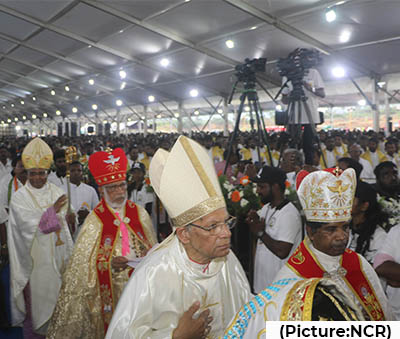 Indicating the esteem with which St. Devasahayam is revered, in attendance were four ministers of the Tamil Nadu state cabinet, led by the speaker of the state legislature, and Hindu leaders.
Indicating the esteem with which St. Devasahayam is revered, in attendance were four ministers of the Tamil Nadu state cabinet, led by the speaker of the state legislature, and Hindu leaders.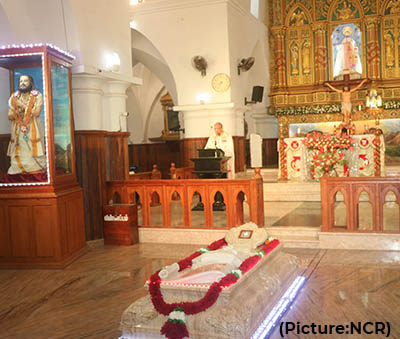 He recalled, “Finally seeing my pitiable condition of being carried around like a baby, my mother relented. It was after weeks of stay and prayer at the care center [at the martyrdom spot] I had a vision of a man in a beard coming and asking me for water. I told him, ‘I cannot walk.’ He said, ‘You can walk’ — and, amazingly, I walked, after months, to bring water for him. But he was gone. Only then I realized it was the saint.”
He recalled, “Finally seeing my pitiable condition of being carried around like a baby, my mother relented. It was after weeks of stay and prayer at the care center [at the martyrdom spot] I had a vision of a man in a beard coming and asking me for water. I told him, ‘I cannot walk.’ He said, ‘You can walk’ — and, amazingly, I walked, after months, to bring water for him. But he was gone. Only then I realized it was the saint.” Some pieces are as old as 600 years! Some of them are the oldest historic Qurans in the United States. This collection includes almost a 100 Qurans and Quranic manuscripts, all written by hand and some of them on bamboo, palm trees and leather!!!
Some pieces are as old as 600 years! Some of them are the oldest historic Qurans in the United States. This collection includes almost a 100 Qurans and Quranic manuscripts, all written by hand and some of them on bamboo, palm trees and leather!!!
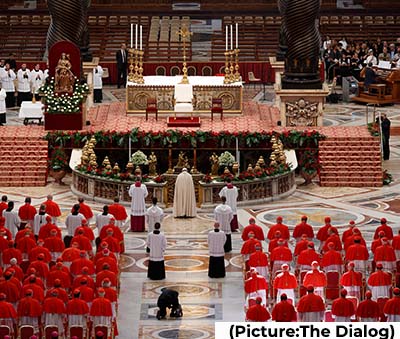 Sixteen of those who will receive the prestigious red cardinal’s hat from Francis in a consistory ceremony at the Vatican on Aug. 27 are younger than 80 and thus would be eligible to vote for his successor if a conclave — in which pontiffs are secretly elected — were to be held.
Sixteen of those who will receive the prestigious red cardinal’s hat from Francis in a consistory ceremony at the Vatican on Aug. 27 are younger than 80 and thus would be eligible to vote for his successor if a conclave — in which pontiffs are secretly elected — were to be held.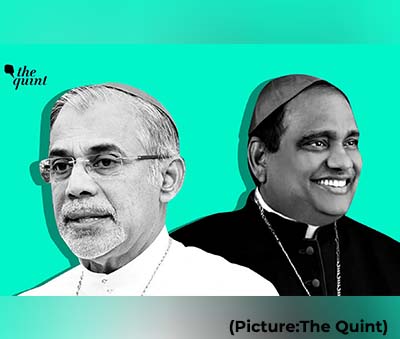 Due to their historical power and influence, they are still called the “Princes of the Church”. It is a reference to those who held the equivalent role of a royal prince and in feudal times ruled a principality. However,
Due to their historical power and influence, they are still called the “Princes of the Church”. It is a reference to those who held the equivalent role of a royal prince and in feudal times ruled a principality. However, 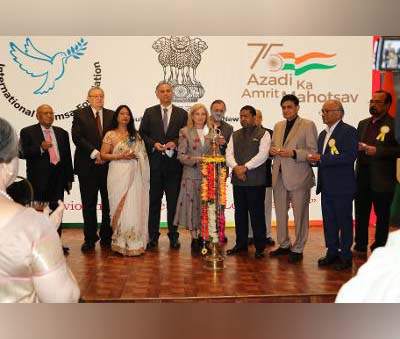 Dr. Jain dwelt on Lord Mahavir who was born in 599 B.C. during the program entitled, “Non-Violence “A Message of Lord Mahavir” on this his 2,620th birth anniversary. She noted the 5 basic principles of Jainism – Non-violence, truthfulness, non-stealing, self-control, and non-possession. She stressed on teaching children the 5 Jain principles to make the world a better place. She also said the Lord Mahavir is the one who told the wotld that “Non-Violence is the Supreme Religon”
Dr. Jain dwelt on Lord Mahavir who was born in 599 B.C. during the program entitled, “Non-Violence “A Message of Lord Mahavir” on this his 2,620th birth anniversary. She noted the 5 basic principles of Jainism – Non-violence, truthfulness, non-stealing, self-control, and non-possession. She stressed on teaching children the 5 Jain principles to make the world a better place. She also said the Lord Mahavir is the one who told the wotld that “Non-Violence is the Supreme Religon”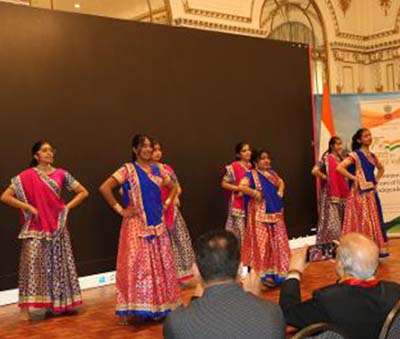 Sister Sabita from Brahma Kumaris at U.N. led the gathering in a moment of contemplation and meditation through breathing exercises. Ambassador Nitzan in his speech, also said on how leaders in several countries had followed the teachings of nonviolence and Ahimsa, which if adhered to by everyone, would not lead to tragedies like the killings in Buffalo or the war in Ukraine. Consul General Jaiswal said he has a special connection to Lord Mahavir because he was born in the same town, Trishala, in Bihar. The Consulate celebrates Mahavir Jayanti every year, he noted, but this year it was even more important as it was part of the Azadi ka Amrit Mahotsav, India’s 75th independence year. “Walk on the path of Lord Mahavir so that we can build a better world to live.
Sister Sabita from Brahma Kumaris at U.N. led the gathering in a moment of contemplation and meditation through breathing exercises. Ambassador Nitzan in his speech, also said on how leaders in several countries had followed the teachings of nonviolence and Ahimsa, which if adhered to by everyone, would not lead to tragedies like the killings in Buffalo or the war in Ukraine. Consul General Jaiswal said he has a special connection to Lord Mahavir because he was born in the same town, Trishala, in Bihar. The Consulate celebrates Mahavir Jayanti every year, he noted, but this year it was even more important as it was part of the Azadi ka Amrit Mahotsav, India’s 75th independence year. “Walk on the path of Lord Mahavir so that we can build a better world to live.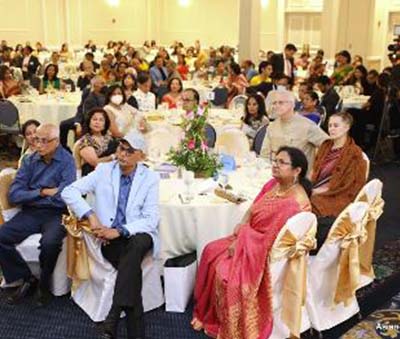 What made this year’s fundraising event exceedingly more memorable, was the attendance of famed Member of Indian Parliament and esteemed Bollywood actress, Hema Malini. She began her career as a bharatanatyam dancer. Hema Malini was able to land her first film role as a dancer in 1963 and starred in over 200 movies throughout her career.
What made this year’s fundraising event exceedingly more memorable, was the attendance of famed Member of Indian Parliament and esteemed Bollywood actress, Hema Malini. She began her career as a bharatanatyam dancer. Hema Malini was able to land her first film role as a dancer in 1963 and starred in over 200 movies throughout her career. 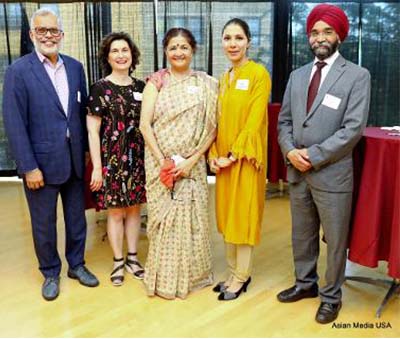 Invited guests Alderwoman Debra Silverstein, Alderman Andre Vasquez Jr of Chicago’s 40th ward, Mr. Ranjit Singh Consul Chicago, Mandala Board President Dr. Umang Patel and Paragi Patel, Pranita Nayar an Indian classical dancer, choreographer, company director, curator and producer, officials from the West Ridge Chamber of Commerce and Rogers Park Business Alliance, and senior officers from the Gaylord and Dorothy Donnelley Foundation, the Richard H. Driehaus Foundation, and the John. D. And Catherine T. MacArthur Foundation.
Invited guests Alderwoman Debra Silverstein, Alderman Andre Vasquez Jr of Chicago’s 40th ward, Mr. Ranjit Singh Consul Chicago, Mandala Board President Dr. Umang Patel and Paragi Patel, Pranita Nayar an Indian classical dancer, choreographer, company director, curator and producer, officials from the West Ridge Chamber of Commerce and Rogers Park Business Alliance, and senior officers from the Gaylord and Dorothy Donnelley Foundation, the Richard H. Driehaus Foundation, and the John. D. And Catherine T. MacArthur Foundation.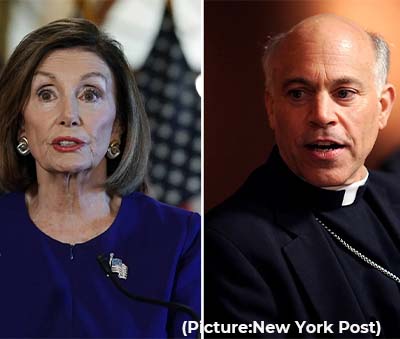 In his letter and in a separate
In his letter and in a separate 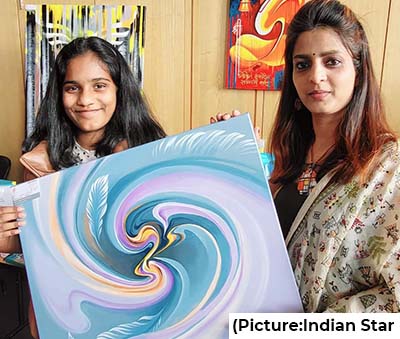 The chief guest of the event was the Indian Ambassador in Dublin, Akhilesh Mishra, who distributed prizes to the winners of the art competitions held during the event.
The chief guest of the event was the Indian Ambassador in Dublin, Akhilesh Mishra, who distributed prizes to the winners of the art competitions held during the event.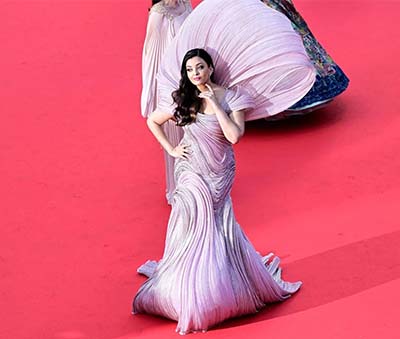 He said, “Aishwarya is a complete woman and a beautiful person. As I got to know her through the process, I discovered a wonderful, spiritual person who is really connected to her soul and is elegant. That purity in the absolute sense of beauty inspired me to think of the concept of the Birth of Venus.”
He said, “Aishwarya is a complete woman and a beautiful person. As I got to know her through the process, I discovered a wonderful, spiritual person who is really connected to her soul and is elegant. That purity in the absolute sense of beauty inspired me to think of the concept of the Birth of Venus.”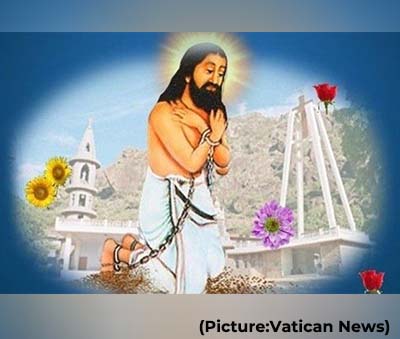 “Saint Devasahayam stood for equality and fought against casteism and communalism. His sainthood comes at a time India is facing a surge in communalism,” said retired Indian civil servant M G Devasahayam, who had written to the Vatican, seeking removal of Devasahayam’s caste name.
“Saint Devasahayam stood for equality and fought against casteism and communalism. His sainthood comes at a time India is facing a surge in communalism,” said retired Indian civil servant M G Devasahayam, who had written to the Vatican, seeking removal of Devasahayam’s caste name.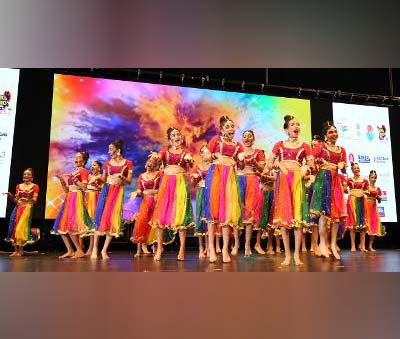 Hon CG Shree Randhir Jaswal welcomed the guests and said that the Indian Diaspora from both the states of Gujarat and Maharashtra, not only in America but in other countries as well, continues to contribute towards the economic and social progress of the countries they live in.
Hon CG Shree Randhir Jaswal welcomed the guests and said that the Indian Diaspora from both the states of Gujarat and Maharashtra, not only in America but in other countries as well, continues to contribute towards the economic and social progress of the countries they live in.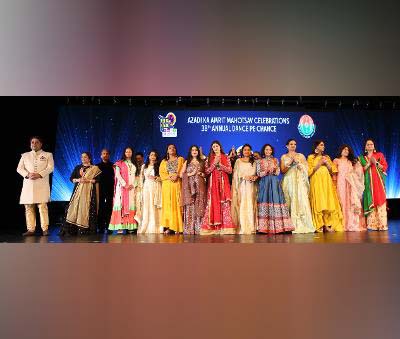 One minute silence was observed in the memory of founding member, Past President and Vice Chairman Emeritus Late Mr. Yashpal Soi. Mr. Vaidya remembered him for his selfless service and dedication to the cause of FIA and lamented the loss FIA has suffered in his passing away.
One minute silence was observed in the memory of founding member, Past President and Vice Chairman Emeritus Late Mr. Yashpal Soi. Mr. Vaidya remembered him for his selfless service and dedication to the cause of FIA and lamented the loss FIA has suffered in his passing away.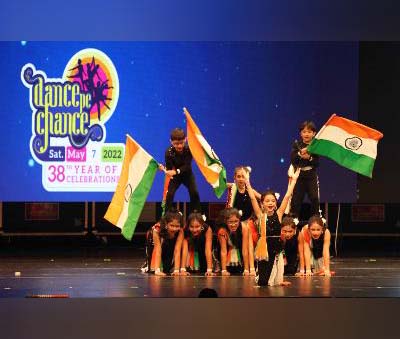 Event Chair, Past President, and member of Board of Trustees of FIA, Sh. Srujal Parikh said it’s a great honor to celebrate the event and took pride in the fact that Gujarat is the Land of Lord Krishna & Mahatma Gandhi. He recognized and felicitated the sponsors, supporters, partner associations, and members in their effort to make the event successful
Event Chair, Past President, and member of Board of Trustees of FIA, Sh. Srujal Parikh said it’s a great honor to celebrate the event and took pride in the fact that Gujarat is the Land of Lord Krishna & Mahatma Gandhi. He recognized and felicitated the sponsors, supporters, partner associations, and members in their effort to make the event successful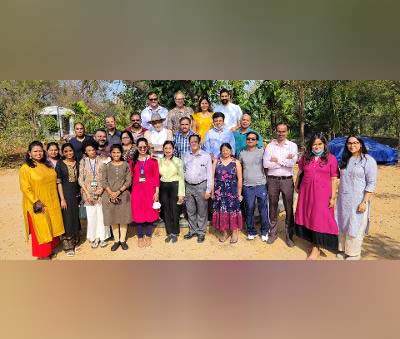 AAPI, the largest ethnic medical organization in the country, representing the interests of over 100,000 physicians of Indian origin, has been focusing on ways to help AAPI members, who have been in the forefront helping millions of patients around the nation, to take care of self and find satisfaction and happiness in the challenging situations they are in, while serving hundreds of patients everyday of their dedicated and noble profession, Dr. Anupama Gotimukula said.
AAPI, the largest ethnic medical organization in the country, representing the interests of over 100,000 physicians of Indian origin, has been focusing on ways to help AAPI members, who have been in the forefront helping millions of patients around the nation, to take care of self and find satisfaction and happiness in the challenging situations they are in, while serving hundreds of patients everyday of their dedicated and noble profession, Dr. Anupama Gotimukula said.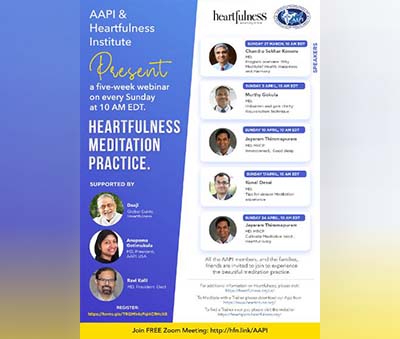 “Our practices include heart-based meditation,” said Dr. Chandra Koneru, an Internal Medicine Professional, AAPI member, and Heartfulness Trainer. “Our values align with the American Association of Physicians of Indian Origin (AAPI) mission to facilitate and enable Indian physicians to improve patient care and engage in research that brings distinctive contributions from India.”
“Our practices include heart-based meditation,” said Dr. Chandra Koneru, an Internal Medicine Professional, AAPI member, and Heartfulness Trainer. “Our values align with the American Association of Physicians of Indian Origin (AAPI) mission to facilitate and enable Indian physicians to improve patient care and engage in research that brings distinctive contributions from India.”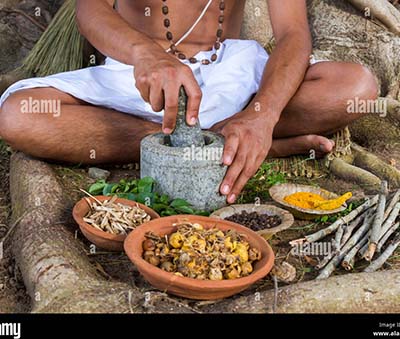 The government also clarified that packed food items used in day to day life for dietary purposes, such as pulses, rice, floor or vegetables etc. shall not be covered under this.
The government also clarified that packed food items used in day to day life for dietary purposes, such as pulses, rice, floor or vegetables etc. shall not be covered under this. He said keeping in mind the spirit of Ek Bharat Shresth Bhara , Midwest Punjabi Association has decided to pay tribute One author from Punjabi ,one from regional language and one from regional language and one from our national language Hindi. We will continue and take forward the spirit of Azadi ka Amrit Mahotsav in all years to come.We all know Gurmeet Singh Dhalwan is a well-known name in the media industry and the Founder President of Adbhhut Media Newspaper and Channel. Dhalwan is an entrepreneur with more than two decades of experience in wholesale & retail business. He is the Founder President of Midwest Punjabi Association, (MPA) a Non-Profit Organization. He is also a member of cultural inclusion and diversity committee/commission Village of Hanover Park, IL. He is a community leader, social worker, and a Philanthropist.
He said keeping in mind the spirit of Ek Bharat Shresth Bhara , Midwest Punjabi Association has decided to pay tribute One author from Punjabi ,one from regional language and one from regional language and one from our national language Hindi. We will continue and take forward the spirit of Azadi ka Amrit Mahotsav in all years to come.We all know Gurmeet Singh Dhalwan is a well-known name in the media industry and the Founder President of Adbhhut Media Newspaper and Channel. Dhalwan is an entrepreneur with more than two decades of experience in wholesale & retail business. He is the Founder President of Midwest Punjabi Association, (MPA) a Non-Profit Organization. He is also a member of cultural inclusion and diversity committee/commission Village of Hanover Park, IL. He is a community leader, social worker, and a Philanthropist. The Sikh Parade returned to the Big Apple after being on hiatus for the past two-years due to COVID-19. The Parade had added poignancy and significance in light of recent violent incidents in which Sikhs have been attacked in their own residential areas and near Gurudwaras over the last few weeks.
The Sikh Parade returned to the Big Apple after being on hiatus for the past two-years due to COVID-19. The Parade had added poignancy and significance in light of recent violent incidents in which Sikhs have been attacked in their own residential areas and near Gurudwaras over the last few weeks. Music and vibrant decorations adorned floats all throughout the parade. Many Sikh members wearing traditional colored garments and turbans. “It’s a symbol so mostly you will see people today especially wearing blue or yellow turbans otherwise you can wear any color — there is no issue with that,” said Hirdepal Singh member of the Sikh Cultural Society in Queens.
Music and vibrant decorations adorned floats all throughout the parade. Many Sikh members wearing traditional colored garments and turbans. “It’s a symbol so mostly you will see people today especially wearing blue or yellow turbans otherwise you can wear any color — there is no issue with that,” said Hirdepal Singh member of the Sikh Cultural Society in Queens.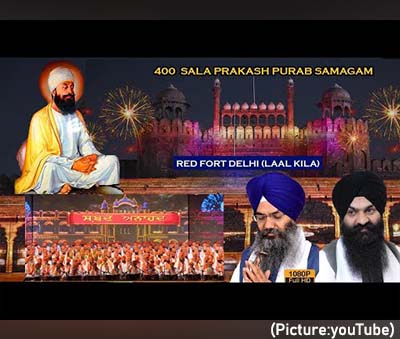 A magnificent stage, which was made of myriad colours of flowers, including rose, marigold, tulip and others, was set up in the middle where
A magnificent stage, which was made of myriad colours of flowers, including rose, marigold, tulip and others, was set up in the middle where  In New York, such a rapid and large-scale loss of life meant that the city’s engine sputtered to an even more devastating halt; in other places, like Mexico and Ecuador, Bangladesh and Nepal, it meant that many families could no longer rely on support from relatives in Queens who were suddenly out of work, or worse.
In New York, such a rapid and large-scale loss of life meant that the city’s engine sputtered to an even more devastating halt; in other places, like Mexico and Ecuador, Bangladesh and Nepal, it meant that many families could no longer rely on support from relatives in Queens who were suddenly out of work, or worse.  Since the 1990s, and especially after major climbing disasters on Everest, Sherpa have left Nepal in large numbers. Many have come to the area around Roosevelt Avenue, where they often work as taxi drivers, or restaurant cooks and supermarket employees. The United Sherpa Association is a central meeting point of worship and community—where people chant and pray, gather for meals of dhal and root-vegetable stews, and share opportunities for work or study.
Since the 1990s, and especially after major climbing disasters on Everest, Sherpa have left Nepal in large numbers. Many have come to the area around Roosevelt Avenue, where they often work as taxi drivers, or restaurant cooks and supermarket employees. The United Sherpa Association is a central meeting point of worship and community—where people chant and pray, gather for meals of dhal and root-vegetable stews, and share opportunities for work or study.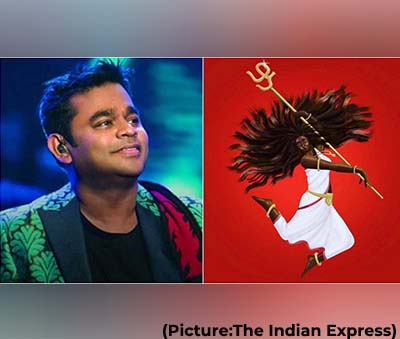 India’s multilingual Bollywood actor Prakash Raj has responded strongly to Union Home Minister Amit Shah’s recent remarks that Hindi should be accepted as an alternative to English. “Amit Shah ji, I want to know where do you want us to speak Hindi, learn Hindi,” asked the actor. The actor joins us on this episode of ‘Left, Right and Centre’.
India’s multilingual Bollywood actor Prakash Raj has responded strongly to Union Home Minister Amit Shah’s recent remarks that Hindi should be accepted as an alternative to English. “Amit Shah ji, I want to know where do you want us to speak Hindi, learn Hindi,” asked the actor. The actor joins us on this episode of ‘Left, Right and Centre’.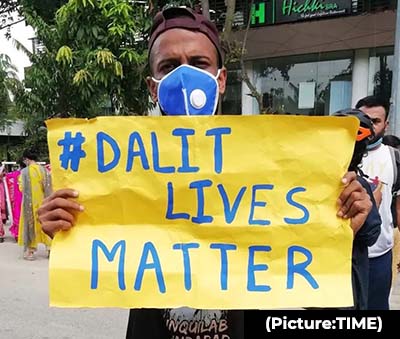 If Hindu unity is a facade, it also follows that the Hindu-Muslim binary, while a common framing for the discussion of Indian politics, cannot be as straightforward as it appears.
If Hindu unity is a facade, it also follows that the Hindu-Muslim binary, while a common framing for the discussion of Indian politics, cannot be as straightforward as it appears.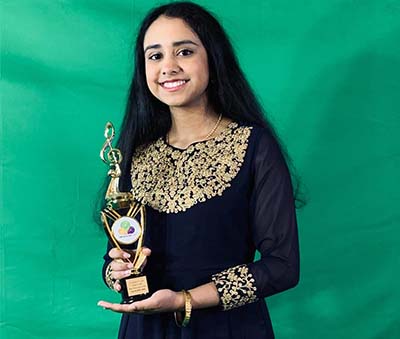 Anushree was recognized at Trumbull High School in 2021 for earning the Outstanding Vocal Music Achievement Award. Her passion for music and art goes to her very young age. The older daughter of Unni and Radha Thoyakat, Anushree started singing for Freshmen Choir and was lucky to be a student of Ms. Anne Tornillo, the pervious Choral Music director at Trumbull High who retired in May 2020. Encouraged by her current music teacher Mr. Chris Wasko in her current endeavors. “None of her musical accomplishments in and out of school would have been possible without the foundational guidence and support from the Trumbull High Music Department. I am forever grateful to all who have shown their love and kind words,” Anushree says with modesty.
Anushree was recognized at Trumbull High School in 2021 for earning the Outstanding Vocal Music Achievement Award. Her passion for music and art goes to her very young age. The older daughter of Unni and Radha Thoyakat, Anushree started singing for Freshmen Choir and was lucky to be a student of Ms. Anne Tornillo, the pervious Choral Music director at Trumbull High who retired in May 2020. Encouraged by her current music teacher Mr. Chris Wasko in her current endeavors. “None of her musical accomplishments in and out of school would have been possible without the foundational guidence and support from the Trumbull High Music Department. I am forever grateful to all who have shown their love and kind words,” Anushree says with modesty.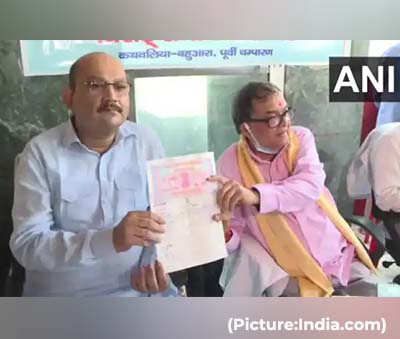 “He recently completed all formalities pertaining to the donation of land belonging to his family for the construction of the temple at the registrar office of the Kesharia sub-division (East Chanmparan),” Kunal, a former police officer, told reporters.
“He recently completed all formalities pertaining to the donation of land belonging to his family for the construction of the temple at the registrar office of the Kesharia sub-division (East Chanmparan),” Kunal, a former police officer, told reporters.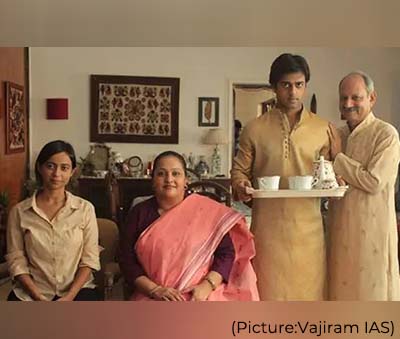 Indian adults nearly universally say it is important for women to have the same rights as men, including eight-in-ten who say this is very important. At the same time, however, there are circumstances when Indians feel men should receive preferential treatment: 80% agree with the idea that “when there are few jobs, men should have more rights to a job than women,” according to
Indian adults nearly universally say it is important for women to have the same rights as men, including eight-in-ten who say this is very important. At the same time, however, there are circumstances when Indians feel men should receive preferential treatment: 80% agree with the idea that “when there are few jobs, men should have more rights to a job than women,” according to 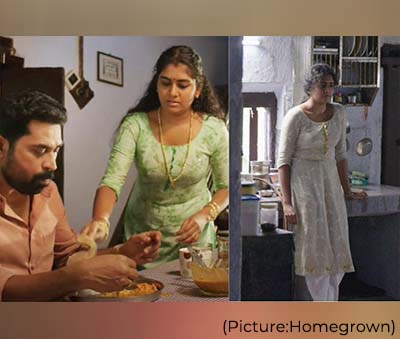 Meanwhile, nearly nine-in-ten Indians (87%) completely or mostly agree with the notion that “a wife must always obey her husband.” This includes a majority of Indians (64%) who completely agree with this sentiment. Women are only modestly less likely than men to say that wives should obey their husbands in all situations, and most Indian women express total agreement with this sentiment (61% vs. 67% among men). (Throughout this report, differences in opinion between men and women are modest. In other words, Indian women typically are not much more likely than Indian men to express egalitarian views on gender roles.)
Meanwhile, nearly nine-in-ten Indians (87%) completely or mostly agree with the notion that “a wife must always obey her husband.” This includes a majority of Indians (64%) who completely agree with this sentiment. Women are only modestly less likely than men to say that wives should obey their husbands in all situations, and most Indian women express total agreement with this sentiment (61% vs. 67% among men). (Throughout this report, differences in opinion between men and women are modest. In other words, Indian women typically are not much more likely than Indian men to express egalitarian views on gender roles.)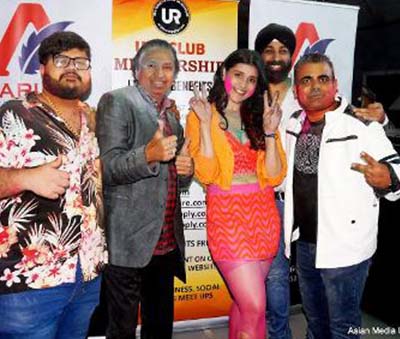 The main highlight of the event came when participants picked up colored powder and chased each other, tossing colors into the air and covering friends and strangers alike. They joy and excitement filled the air and created a memorable experience for all.
The main highlight of the event came when participants picked up colored powder and chased each other, tossing colors into the air and covering friends and strangers alike. They joy and excitement filled the air and created a memorable experience for all. The Aarush Entertainment company offers event planning & management services that also includes wedding designing, planning, management & consultancy, adopting a comprehensive approach & professional management information system to plan and produce a world class event experience each & every time all over the world. The highly skilled team of professionals at Aarush Entertainment strives hard to accomplish the highest standard of quality, effectiveness & novelty with due importance to the budgetary considerations.
The Aarush Entertainment company offers event planning & management services that also includes wedding designing, planning, management & consultancy, adopting a comprehensive approach & professional management information system to plan and produce a world class event experience each & every time all over the world. The highly skilled team of professionals at Aarush Entertainment strives hard to accomplish the highest standard of quality, effectiveness & novelty with due importance to the budgetary considerations.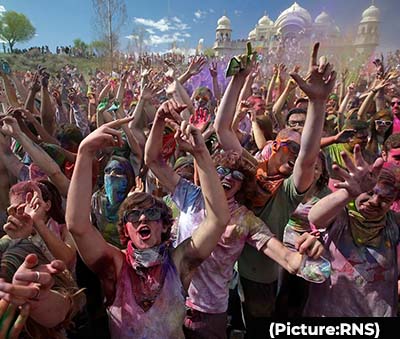 Traditionally celebrated on the last full moon in the lunar month of Phalguna, which falls this year on Friday (March 18), Holi commemorates the triumph of good over evil. In Hindu mythology the demon king Hiranyakashipu commands his subjects to acknowledge him as the supreme God, but his son Prahalada, a devotee of the god Vishnu, refuses. In a rage Hiranyakashipu gives his sister, Holika, a protective cloak and instructs her to take Prahalada in her lap and sit on a burning pyre.
Traditionally celebrated on the last full moon in the lunar month of Phalguna, which falls this year on Friday (March 18), Holi commemorates the triumph of good over evil. In Hindu mythology the demon king Hiranyakashipu commands his subjects to acknowledge him as the supreme God, but his son Prahalada, a devotee of the god Vishnu, refuses. In a rage Hiranyakashipu gives his sister, Holika, a protective cloak and instructs her to take Prahalada in her lap and sit on a burning pyre.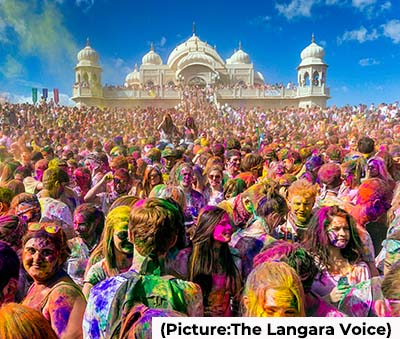 Caru Das, director of the Krishna Temple, said that after the first celebrations started at the temple in 1995, festivities soon moved outdoors to accommodate a rock band, and more people started to come as word got around.
Caru Das, director of the Krishna Temple, said that after the first celebrations started at the temple in 1995, festivities soon moved outdoors to accommodate a rock band, and more people started to come as word got around. Known among his priest friends and the larger Catholic community in Kerala, the state with the maximum number of Christians in the country, having as many as 20% of the state’s population being Christian, the newly consecrated Archbishop Netto is known for his simplicity, goodness at heart, down to earth approach and cordial relationship with one and all.
Known among his priest friends and the larger Catholic community in Kerala, the state with the maximum number of Christians in the country, having as many as 20% of the state’s population being Christian, the newly consecrated Archbishop Netto is known for his simplicity, goodness at heart, down to earth approach and cordial relationship with one and all.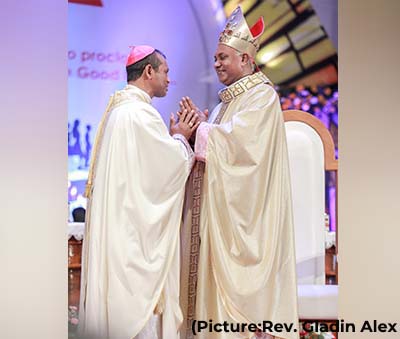 Delivering the benediction, Cardinal Baselios Cleemis Catholicos, Major Archbishop-Catholicos of Malankara Syrian Catholic Church, called upon the new Archbishop to lead the coastal population from the front for their rights and betterment. The benefactors of such efforts must not be the parishioners alone, but the entire community in the region. He also recounted the selfless deeds of the fisher-folks in rescuing those stranded in the floods of 2018.
Delivering the benediction, Cardinal Baselios Cleemis Catholicos, Major Archbishop-Catholicos of Malankara Syrian Catholic Church, called upon the new Archbishop to lead the coastal population from the front for their rights and betterment. The benefactors of such efforts must not be the parishioners alone, but the entire community in the region. He also recounted the selfless deeds of the fisher-folks in rescuing those stranded in the floods of 2018.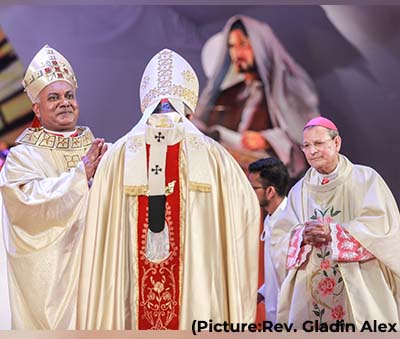 During his long pastoral ministry, serving the Church, Archbishop Netto has held the following offices: He was the parish vicar in Peringamala (1990-1991) and of the Cathedral of Palayam (1991-1995) and executive secretary for ecumenism and interreligious dialogue (1994-1995). He then served as parish priest in Pettah (1999-2003), and executive secretary for the Basic Christian Communities (2000-2004) and rector of Saint Vincent’s Minor Seminary in Trivandrum (2003-2010).
During his long pastoral ministry, serving the Church, Archbishop Netto has held the following offices: He was the parish vicar in Peringamala (1990-1991) and of the Cathedral of Palayam (1991-1995) and executive secretary for ecumenism and interreligious dialogue (1994-1995). He then served as parish priest in Pettah (1999-2003), and executive secretary for the Basic Christian Communities (2000-2004) and rector of Saint Vincent’s Minor Seminary in Trivandrum (2003-2010).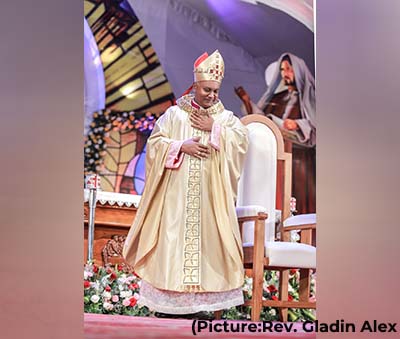 The diocese of Trivandrum was established by His Holiness Pope Pius XI on July 1, 1937 through the Bull “In Ora Malabarica” with the four taluks of Neyyantinkara, Nedumangad, Trivandrum and Chirayinkeezh bifurcated from the diocese of Quilon.
The diocese of Trivandrum was established by His Holiness Pope Pius XI on July 1, 1937 through the Bull “In Ora Malabarica” with the four taluks of Neyyantinkara, Nedumangad, Trivandrum and Chirayinkeezh bifurcated from the diocese of Quilon.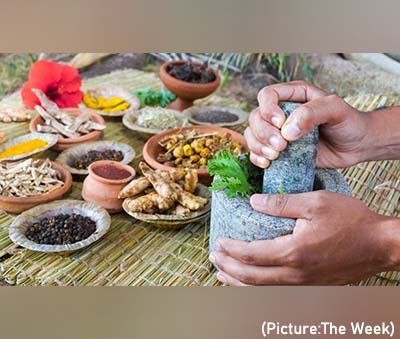 The WHO GCTM will be established in Jamnagar under the Ministry of AYUSH. A Joint Task Force (JTF) is constituted for coordination, execution and monitoring of activities for the establishment of this Centre.
The WHO GCTM will be established in Jamnagar under the Ministry of AYUSH. A Joint Task Force (JTF) is constituted for coordination, execution and monitoring of activities for the establishment of this Centre.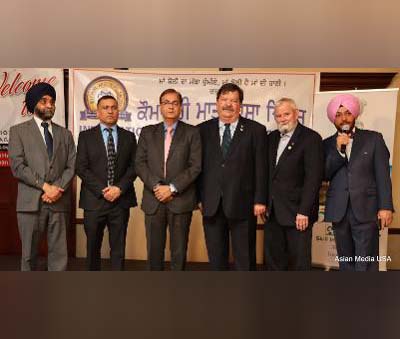 The programme started with rendition of Gurbani Kirtan with classical Indian string instruments – Taus and Dilruba by youth from Chicago suburbs. Several noted Punjabi academicians, authors, and representatives of Punjabi linguistic/cultural organizations gave presentations on their initiatives to preserve linguistic and cultural heritage of Punjabi immigrants in the US. These included Mr. Ashok Bhaura, Punjabi writer and journalist in California, Dr. Pinderjeet Kaur Gill, Lecturer, Hindi and Punjabi Languages at University of Michigan, Dr. Gurbakhsh Singh Bhandal, a Physicist at Cleveland State University, Ohio, and Mr. Manmohan Grewal, TV Anchor from Utah.
The programme started with rendition of Gurbani Kirtan with classical Indian string instruments – Taus and Dilruba by youth from Chicago suburbs. Several noted Punjabi academicians, authors, and representatives of Punjabi linguistic/cultural organizations gave presentations on their initiatives to preserve linguistic and cultural heritage of Punjabi immigrants in the US. These included Mr. Ashok Bhaura, Punjabi writer and journalist in California, Dr. Pinderjeet Kaur Gill, Lecturer, Hindi and Punjabi Languages at University of Michigan, Dr. Gurbakhsh Singh Bhandal, a Physicist at Cleveland State University, Ohio, and Mr. Manmohan Grewal, TV Anchor from Utah. Speaking about “the fundamental theology of the priesthood” at the conference, which was organized by the Vatican’s Congregation for Bishops and the Center for the Research and Anthropology of Vocations, Pope Francis identified “mercenary” attitudes that emerge during crisis.
Speaking about “the fundamental theology of the priesthood” at the conference, which was organized by the Vatican’s Congregation for Bishops and the Center for the Research and Anthropology of Vocations, Pope Francis identified “mercenary” attitudes that emerge during crisis.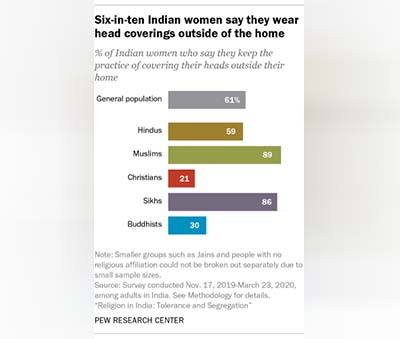 Head coverings are relatively common among Indian women. About six-in-ten women in India (61%) say they keep the practice of covering their heads outside of their homes, according to a
Head coverings are relatively common among Indian women. About six-in-ten women in India (61%) say they keep the practice of covering their heads outside of their homes, according to a 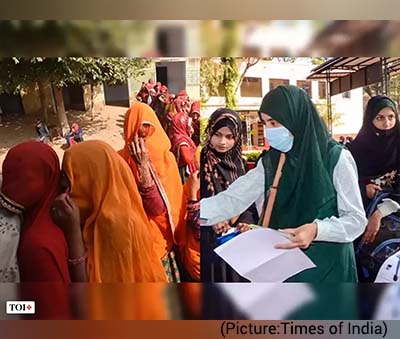 These regional differences are largely driven by Hindu women, as Muslim women tend to keep the practice of covering their heads in public regardless of what region they live in. This leads to large differences between Muslims and Hindus in the South in particular.
These regional differences are largely driven by Hindu women, as Muslim women tend to keep the practice of covering their heads in public regardless of what region they live in. This leads to large differences between Muslims and Hindus in the South in particular. Nationally, head coverings tend to be more common among women who are older, married, more religious and who have less formal educational attainment. The practice is also more prevalent in rural areas.
Nationally, head coverings tend to be more common among women who are older, married, more religious and who have less formal educational attainment. The practice is also more prevalent in rural areas. “This is a great moment for India to see the Sacred Ensembles of the Hoysalas temples being submitted for inscription in the World Heritage List.”
“This is a great moment for India to see the Sacred Ensembles of the Hoysalas temples being submitted for inscription in the World Heritage List.” Brijendra Singh, a 77-year-old tour guide, has shown visitors around the famed Khajuraho group of Hindu and Jain temples for 52 years.
Brijendra Singh, a 77-year-old tour guide, has shown visitors around the famed Khajuraho group of Hindu and Jain temples for 52 years.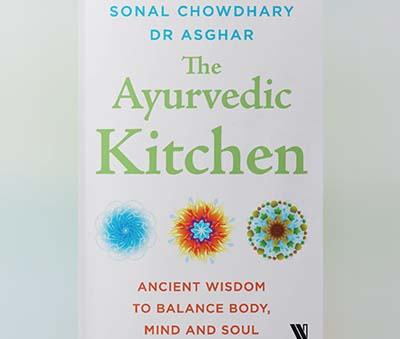 They say the book is for anyone who is looking to reset their food habits which are in sync with their own body, mind and health.
They say the book is for anyone who is looking to reset their food habits which are in sync with their own body, mind and health. At a time when several Opposition-ruled states complained that their tableaux were not selected for the Republic Day parade, even as the government insisted that the decision was taken by an expert committee and there is no political intervention, the tableaux of four of the five poll-bound states made it to Rajpath on Republic Day.
At a time when several Opposition-ruled states complained that their tableaux were not selected for the Republic Day parade, even as the government insisted that the decision was taken by an expert committee and there is no political intervention, the tableaux of four of the five poll-bound states made it to Rajpath on Republic Day.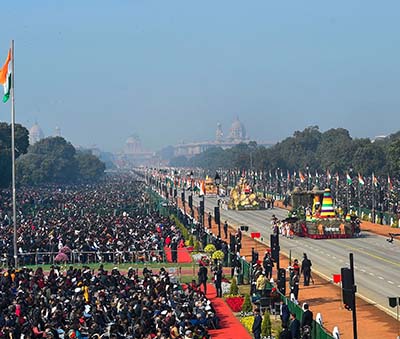 The Air Force tableau paid homage to the victory over Pakistan in the 1971 War, with models of MiG 21, Gnat — both of which were used in the war — and the Light Combat Helicopters. DRDO showcased major weapon platforms developed by it, including the Light Combat Aircraft Tejas and an Air Independent Propulsion system it is working on for the submarines.
The Air Force tableau paid homage to the victory over Pakistan in the 1971 War, with models of MiG 21, Gnat — both of which were used in the war — and the Light Combat Helicopters. DRDO showcased major weapon platforms developed by it, including the Light Combat Aircraft Tejas and an Air Independent Propulsion system it is working on for the submarines. Meanwhile, Goa showed symbols of its heritage and Haryana had a simplistic tableau with several sportsmen from the state on a “victory chariot” carrying the national flag. The idea was to highlight that although it occupies only 1.3 per cent of the country’s landmass and 2.09 per cent of the population, sportsmen from the state have brought maximum medals for the country in various international sporting events, including the Olympics.
Meanwhile, Goa showed symbols of its heritage and Haryana had a simplistic tableau with several sportsmen from the state on a “victory chariot” carrying the national flag. The idea was to highlight that although it occupies only 1.3 per cent of the country’s landmass and 2.09 per cent of the population, sportsmen from the state have brought maximum medals for the country in various international sporting events, including the Olympics.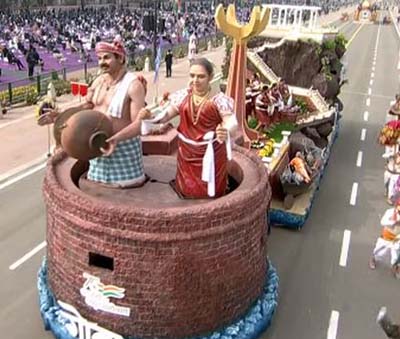 Maharashtra showed the rich biodiversity of the state, with 15 animals and 22 plants as a part of the tableau, including large models of the Blue Mormon Butterfly and more.
Maharashtra showed the rich biodiversity of the state, with 15 animals and 22 plants as a part of the tableau, including large models of the Blue Mormon Butterfly and more.
 “When I first wrote this book of my heart, I wasn’t sure whether anyone else would want to read it or care about it. Seeing it recognized in this way is so incredible and humbling. The world needs all kinds of stories!” LaRocca says on her eponymous website rajanilarocca.com. “This story was inspired by aspects of my own life and childhood, and is dedicated to my parents, who are my heroes,” she adds.
“When I first wrote this book of my heart, I wasn’t sure whether anyone else would want to read it or care about it. Seeing it recognized in this way is so incredible and humbling. The world needs all kinds of stories!” LaRocca says on her eponymous website rajanilarocca.com. “This story was inspired by aspects of my own life and childhood, and is dedicated to my parents, who are my heroes,” she adds. The President of FIACONA, Mr. Koshi George said, “The Modi government has sunk to a new low, just when you thought it could not possibly sink any further. The act of removing the hymn from India’s Republic Day Parade to be held this Wednesday (Jan 26), shows the silliness and deep-rooted hatred of this party against anything that resembles the Christian faith”.
The President of FIACONA, Mr. Koshi George said, “The Modi government has sunk to a new low, just when you thought it could not possibly sink any further. The act of removing the hymn from India’s Republic Day Parade to be held this Wednesday (Jan 26), shows the silliness and deep-rooted hatred of this party against anything that resembles the Christian faith”. Rev. Peter Cook, the Executive Director of the NY State Council of Churches, a part of the National Council of Churches (NCC-USA) said that, “The action of the Modi government is not only an insult to the sentiments of over 100 million people who follow the faith in India but also to millions of other people from all faith backgrounds. With this kind of open hostilities against people of faith in India, it’s no wonder people like Dr. Gregory Stanton of Genocide Watch warn that India would be where the next genocide takes place”.
Rev. Peter Cook, the Executive Director of the NY State Council of Churches, a part of the National Council of Churches (NCC-USA) said that, “The action of the Modi government is not only an insult to the sentiments of over 100 million people who follow the faith in India but also to millions of other people from all faith backgrounds. With this kind of open hostilities against people of faith in India, it’s no wonder people like Dr. Gregory Stanton of Genocide Watch warn that India would be where the next genocide takes place”. Thirteen rounds were conducted on the DD National channel between 7 and 7:30 am. Many leading Yoga gurus and institutes like the Indian Yoga Association, National Yoga Sports Federation participated. In his address, Sonowal highlighted the advantages, “Scientifically, the Surya Namaskar has been known to develop immunity and improve vitality, which is significant to our health during the pandemic conditions.”
Thirteen rounds were conducted on the DD National channel between 7 and 7:30 am. Many leading Yoga gurus and institutes like the Indian Yoga Association, National Yoga Sports Federation participated. In his address, Sonowal highlighted the advantages, “Scientifically, the Surya Namaskar has been known to develop immunity and improve vitality, which is significant to our health during the pandemic conditions.” My family traces its lineage to the Southern Indian state of Tamil Nadu, where our faith was shaped by thousands of years of rituals and rites of worship, some of them germane only to Tamils.
My family traces its lineage to the Southern Indian state of Tamil Nadu, where our faith was shaped by thousands of years of rituals and rites of worship, some of them germane only to Tamils.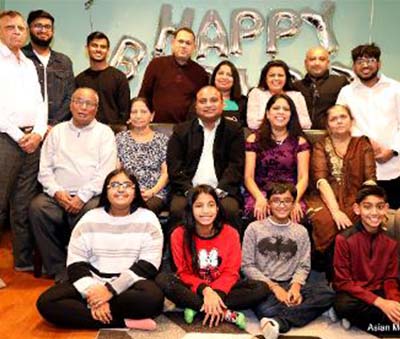 Born in the historical year of India’s Independence, 1947, to Shri Govind Lal Kothari and Smt. Sharda Kothari, in a small town of Gujarat called Kadi, Hasmukh finished his education with a degree in Civil Engineering, after which he procured a job as an assistant lecturer in Mumbai. In 1968, Hasmukh married Usha to start a blissful family life.
Born in the historical year of India’s Independence, 1947, to Shri Govind Lal Kothari and Smt. Sharda Kothari, in a small town of Gujarat called Kadi, Hasmukh finished his education with a degree in Civil Engineering, after which he procured a job as an assistant lecturer in Mumbai. In 1968, Hasmukh married Usha to start a blissful family life.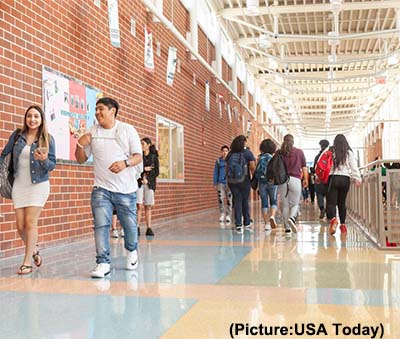 This reformative initiative requires the schools to display language outside of restrooms, informing students, whether male or female, that they may use the restroom that aligns with their gender identity. CPS prompted others, “We require all schools to adopt new signage to make our restrooms more inclusive. This is a big step forward for gender equity for our students and staff.” Is it going to influence the schooling practices themselves, or will it just be ignored?
This reformative initiative requires the schools to display language outside of restrooms, informing students, whether male or female, that they may use the restroom that aligns with their gender identity. CPS prompted others, “We require all schools to adopt new signage to make our restrooms more inclusive. This is a big step forward for gender equity for our students and staff.” Is it going to influence the schooling practices themselves, or will it just be ignored? While COVID-19 clearly played a role in this near-zero population growth, that growth had begun to plummet even before the pandemic. The 2020 census showed that from 2010 to 2020, the U.S. registered the
While COVID-19 clearly played a role in this near-zero population growth, that growth had begun to plummet even before the pandemic. The 2020 census showed that from 2010 to 2020, the U.S. registered the 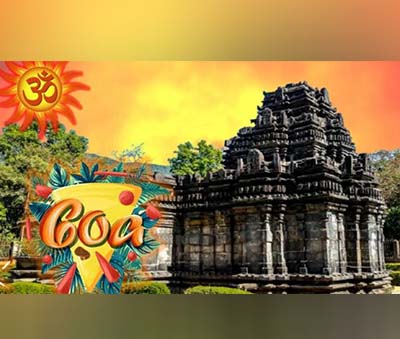 According to India Tourism Statistics 2019, a government of India publication, in 2017, Goa had 68,95,234 domestic and 8,42,220 foreign tourists while in 2018, the respective number of 70,81,559 and 9,33,841 showing a growth rate of 2.70 per cent and 10.88 per cent, respectively. Of course, the pandemic changed the situation, and the tourism sector was the hardest hit. In 2021, even when the domestic sector has picked up slowly, foreign tourists’ numbers are no match.
According to India Tourism Statistics 2019, a government of India publication, in 2017, Goa had 68,95,234 domestic and 8,42,220 foreign tourists while in 2018, the respective number of 70,81,559 and 9,33,841 showing a growth rate of 2.70 per cent and 10.88 per cent, respectively. Of course, the pandemic changed the situation, and the tourism sector was the hardest hit. In 2021, even when the domestic sector has picked up slowly, foreign tourists’ numbers are no match. “Life is better with friends,” Jacob Abraham told the participants in his welcome address, providing insight into the objectives of creating the Hedge Social Club. “Friends are the ones who know you and are always there when you need them most. During the pandemic times, a sense of community is more important now than ever before. People near you are looking to form connections and find support.”
“Life is better with friends,” Jacob Abraham told the participants in his welcome address, providing insight into the objectives of creating the Hedge Social Club. “Friends are the ones who know you and are always there when you need them most. During the pandemic times, a sense of community is more important now than ever before. People near you are looking to form connections and find support.” Senator Kevin Thomas of the New York State greeted the audience. Guest of Honor was Dr. Freemu Varghese, Founder and CEO of Freedia Media. Minos Abraham served eloquently as the Emcee for the program. Biju Chacko, a BOD member of IAPC introduced Jacob Abraham to the audience.
Senator Kevin Thomas of the New York State greeted the audience. Guest of Honor was Dr. Freemu Varghese, Founder and CEO of Freedia Media. Minos Abraham served eloquently as the Emcee for the program. Biju Chacko, a BOD member of IAPC introduced Jacob Abraham to the audience. Stating that Hedge Club is a forum to “Meet new people at the Hedge Club, which is the ultimate group” Jacob Abraham said, “HEDGE CLUB is the one you always wanted to be part of. A group that you feel you belong to, and you believe it to be an integral part of who you are.” The Club members meet every month and celebrate and enhance their fellowship and joy. To join the Group and expand one’s friends circle and spend quality time with people, please call Saji Abraham at: 516. 606.3268.
Stating that Hedge Club is a forum to “Meet new people at the Hedge Club, which is the ultimate group” Jacob Abraham said, “HEDGE CLUB is the one you always wanted to be part of. A group that you feel you belong to, and you believe it to be an integral part of who you are.” The Club members meet every month and celebrate and enhance their fellowship and joy. To join the Group and expand one’s friends circle and spend quality time with people, please call Saji Abraham at: 516. 606.3268.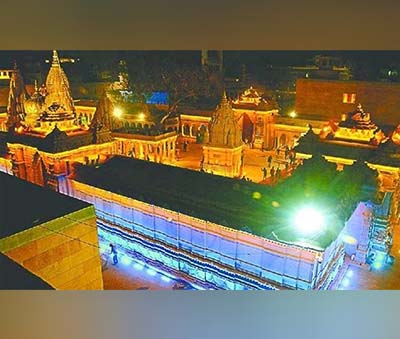 ‘Kashi and Ganga belong to all. The invaders attacked this city, tried to destroy it. The history of Aurangzeb’s atrocities, his terror tried to change civilization by the sword.
‘Kashi and Ganga belong to all. The invaders attacked this city, tried to destroy it. The history of Aurangzeb’s atrocities, his terror tried to change civilization by the sword. The documentary, which will air in the early evening, is one piece of a campaign launched by NSC to bring more awareness to the Sikh faith, the world’s fifth-largest religion, and to garner acknowledgement of key dates in the life of the faith’s founder. The film is set to be broadcast in 15 of America’s largest metropolitan areas including Houston, San Francisco and Washington, D.C.
The documentary, which will air in the early evening, is one piece of a campaign launched by NSC to bring more awareness to the Sikh faith, the world’s fifth-largest religion, and to garner acknowledgement of key dates in the life of the faith’s founder. The film is set to be broadcast in 15 of America’s largest metropolitan areas including Houston, San Francisco and Washington, D.C.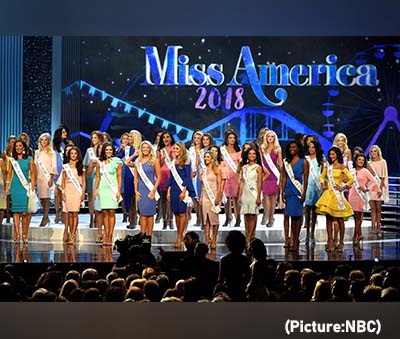 Faithful Miss America organizers and enthusiasts contend the annual ritual is here to stay and will keep changing with the times. And even though they may not have indeed devised a plan for world peace, many participants say the organization — a large provider of scholarship assistance to young women — has been life-altering, opening doors for them professionally and personally. Others should have the same opportunities, they say.
Faithful Miss America organizers and enthusiasts contend the annual ritual is here to stay and will keep changing with the times. And even though they may not have indeed devised a plan for world peace, many participants say the organization — a large provider of scholarship assistance to young women — has been life-altering, opening doors for them professionally and personally. Others should have the same opportunities, they say.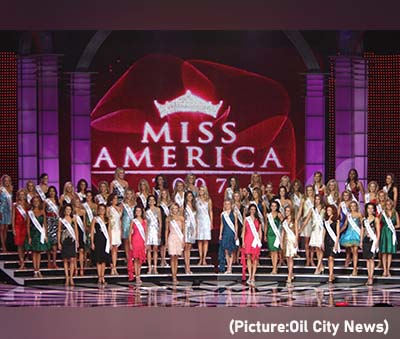 Miss America President and CEO Shantel Krebs, a former South Dakota secretary of state who does not take a salary, contends the Miss America organization is “committed to diversity, equity and inclusion.”
Miss America President and CEO Shantel Krebs, a former South Dakota secretary of state who does not take a salary, contends the Miss America organization is “committed to diversity, equity and inclusion.”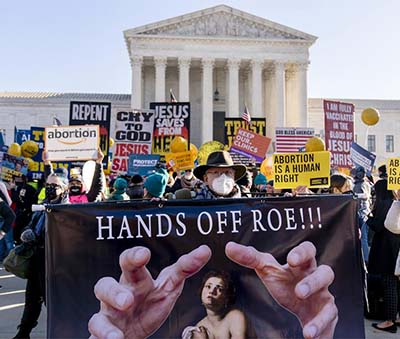 The need for Democrats to manage resources between federal and state races could create some uncomfortable conversations over the coming months.
The need for Democrats to manage resources between federal and state races could create some uncomfortable conversations over the coming months. The tireless efforts of the county and founding members along with a dedicated Hosts committee of Dr. Bobby K. Kalotee, Chairperson Indu Jaiswal, Beena Kothari, Flora Parekh, Jasbir (Jay) Singh, Mukesh Modi, Shashi Malik, Sunita Manjrekar, Deepak Bansal, Indu Gajwani, Anju Sharma and several volunteers and supporters, contributed to the success of the event keeping up the spirit of Diwali.
The tireless efforts of the county and founding members along with a dedicated Hosts committee of Dr. Bobby K. Kalotee, Chairperson Indu Jaiswal, Beena Kothari, Flora Parekh, Jasbir (Jay) Singh, Mukesh Modi, Shashi Malik, Sunita Manjrekar, Deepak Bansal, Indu Gajwani, Anju Sharma and several volunteers and supporters, contributed to the success of the event keeping up the spirit of Diwali.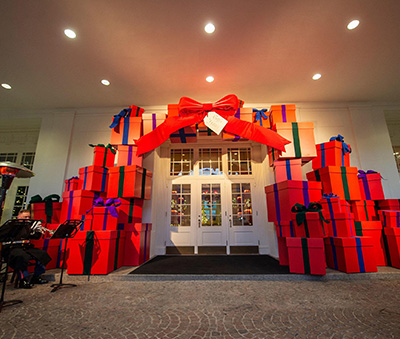 “The things we hold sacred unite us and transcend distance, time, and even the constraints of a pandemic: faith, family, and friendship; a love of the arts, learning, and nature; gratitude, service, and community; unity and peace. These are the gifts that tie together the heart strings of our lives.”
“The things we hold sacred unite us and transcend distance, time, and even the constraints of a pandemic: faith, family, and friendship; a love of the arts, learning, and nature; gratitude, service, and community; unity and peace. These are the gifts that tie together the heart strings of our lives.”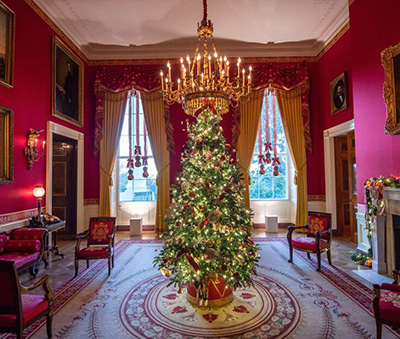 The Red Room, decorated to represent the gift of the performing arts, includes brass instruments hanging from the mantel. Ballet slippers, tap shoes and musical notes are strung around the tree.
The Red Room, decorated to represent the gift of the performing arts, includes brass instruments hanging from the mantel. Ballet slippers, tap shoes and musical notes are strung around the tree.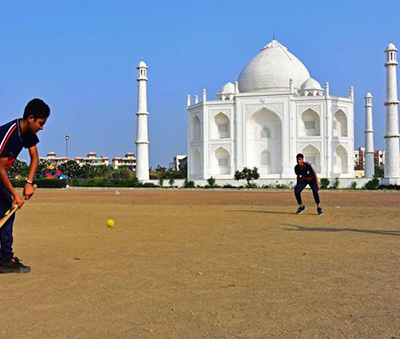 Mr Chouksey’s replica – nestled deep inside his sprawling 50-acre property, which includes a hospital, has also been attracting a steady stream of visitors.
Mr Chouksey’s replica – nestled deep inside his sprawling 50-acre property, which includes a hospital, has also been attracting a steady stream of visitors.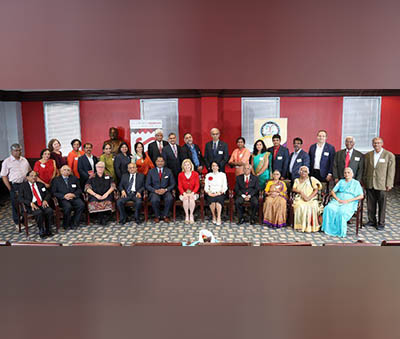 The initial $1 million pledge will create The Houston Tamil Studies Chair, Inc. Research Endowment in the UH College of Liberal Arts and Social Sciences. These funds will support research program costs, equipment and seminars with invited scholars who are experts on Tamil societies and the Tamil diaspora in the United States.
The initial $1 million pledge will create The Houston Tamil Studies Chair, Inc. Research Endowment in the UH College of Liberal Arts and Social Sciences. These funds will support research program costs, equipment and seminars with invited scholars who are experts on Tamil societies and the Tamil diaspora in the United States.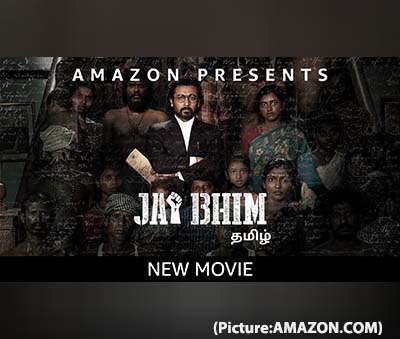 Directed by TJ Gnanavel, the film stars actors
Directed by TJ Gnanavel, the film stars actors 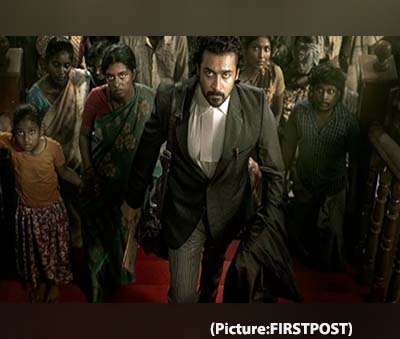 A man named Rajakannu from the Irular tribe was falsely framed in a theft case. The horrific death of Rajakannu due to the custodial torture was a challenging and landmark legal battle for K Chandru when the victim’s wife Sengani (real name Parvathi) came to the lawyer for help.
A man named Rajakannu from the Irular tribe was falsely framed in a theft case. The horrific death of Rajakannu due to the custodial torture was a challenging and landmark legal battle for K Chandru when the victim’s wife Sengani (real name Parvathi) came to the lawyer for help. Americans are known the world over for saying “thank you”
Americans are known the world over for saying “thank you”  In American English, many of the expressions of gratitude are couched in transactional language that involves expressions of
In American English, many of the expressions of gratitude are couched in transactional language that involves expressions of 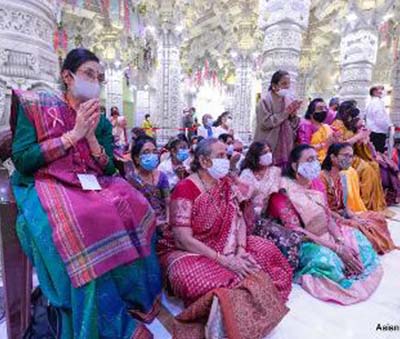 The celebrations offered attendees an opportunity for darshan of the annakut and divine murtis of God while arti and thaal were sung throughout the day. Visitors were also inspired through an exhibition on with informational posters and decorations describing different traditions and stories behind the multi-day festival. In expressing the warmth and goodwill of Diwali, prasad in the form of sweets was distributed to all those joining in the celebrations. The festivities were open to all members of the local community.
The celebrations offered attendees an opportunity for darshan of the annakut and divine murtis of God while arti and thaal were sung throughout the day. Visitors were also inspired through an exhibition on with informational posters and decorations describing different traditions and stories behind the multi-day festival. In expressing the warmth and goodwill of Diwali, prasad in the form of sweets was distributed to all those joining in the celebrations. The festivities were open to all members of the local community.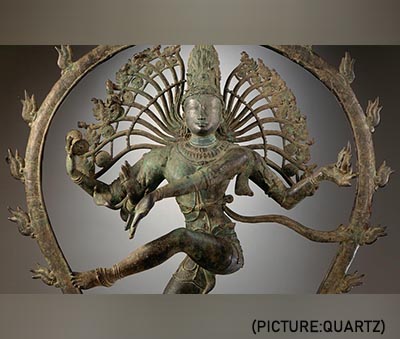 For 16 years he has been working to repatriate gods and goddesses looted from India over the years, and the challenges remain huge, he tells us in today’s episode. For example, in 2020, police seized 19,000 stolen artefacts in an international art trafficking crackdown. 101 suspects were arrested with treasures from around the world, including Colombian and Roman antiquities. One activist estimates that in France alone there are 116,000 African objects that should be returned.
For 16 years he has been working to repatriate gods and goddesses looted from India over the years, and the challenges remain huge, he tells us in today’s episode. For example, in 2020, police seized 19,000 stolen artefacts in an international art trafficking crackdown. 101 suspects were arrested with treasures from around the world, including Colombian and Roman antiquities. One activist estimates that in France alone there are 116,000 African objects that should be returned.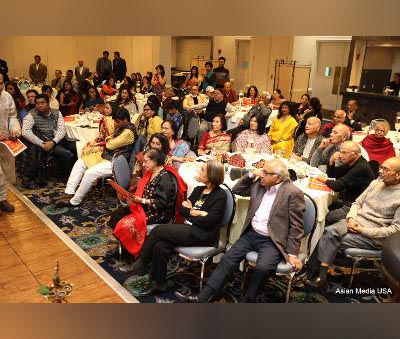 The event started with a Diya lighting ceremony by executive committee and board of trustees members led by Dr. Subhash Pandey and Chief Guest, Mr. PK Mishra, and was followed by a beautiful sitar instrumental presentation of bhajan medley by Mr. Paneesh Rao. The program was organized and coordinated by Mr. Sunish Mittal and Mr. Raj Kumar Upadhyay, treasurer and president of the UP Association, respectively.
The event started with a Diya lighting ceremony by executive committee and board of trustees members led by Dr. Subhash Pandey and Chief Guest, Mr. PK Mishra, and was followed by a beautiful sitar instrumental presentation of bhajan medley by Mr. Paneesh Rao. The program was organized and coordinated by Mr. Sunish Mittal and Mr. Raj Kumar Upadhyay, treasurer and president of the UP Association, respectively.  The Association brought in several renowned artists from Chicago who presented a range of traditional, modern, and contemporary Indian performances, including an outstanding dance (Ganesh Vandana and Shri Ram stuti) by Mrs. Gauri Jog, director & teacher, India dance school. This was followed by several melodious songs by two well-known singers, Mrs. Ananya Ghosh and Mr. Sreepathy that were accompanied by an outstanding musician team. This was followed by a program called “Saaz aur Alfaaz” by Mr. Rakesh Malhotra, a famous poet, and Mr. Sunish Mittal, a well accomplished singer. Two children’s performers, Mr. Shlok Jaiswal and Ms. Anavi Ghosh also sang melodious songs for this occasion. The program ended with a presentation of a colorful group dance to a Bollywood movie song.
The Association brought in several renowned artists from Chicago who presented a range of traditional, modern, and contemporary Indian performances, including an outstanding dance (Ganesh Vandana and Shri Ram stuti) by Mrs. Gauri Jog, director & teacher, India dance school. This was followed by several melodious songs by two well-known singers, Mrs. Ananya Ghosh and Mr. Sreepathy that were accompanied by an outstanding musician team. This was followed by a program called “Saaz aur Alfaaz” by Mr. Rakesh Malhotra, a famous poet, and Mr. Sunish Mittal, a well accomplished singer. Two children’s performers, Mr. Shlok Jaiswal and Ms. Anavi Ghosh also sang melodious songs for this occasion. The program ended with a presentation of a colorful group dance to a Bollywood movie song.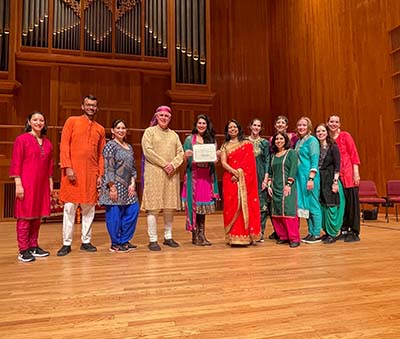 Diwali – known as the festival of lights – is one of the major festivals celebrated by Hindus, Jains, Sikhs and even some Buddhists. Each religion has its own historical narrative behind the holiday. Diwali is widely observed among more than a billion people from a variety of faiths across India and its diaspora. The five days of Diwali are marked by prayer, feasts, fireworks, family gatherings, and charitable giving.
Diwali – known as the festival of lights – is one of the major festivals celebrated by Hindus, Jains, Sikhs and even some Buddhists. Each religion has its own historical narrative behind the holiday. Diwali is widely observed among more than a billion people from a variety of faiths across India and its diaspora. The five days of Diwali are marked by prayer, feasts, fireworks, family gatherings, and charitable giving.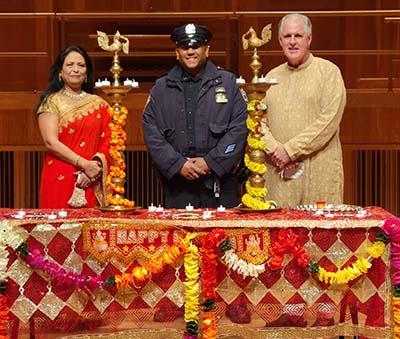 “May the lamps (Diya) of Diwali (Deepavali) illuminate everyone’s life with happiness, peace and good health. Wish you and your family a very prosperous Diwali and a happy new year! On this Diwali, let’s make a promise to bring lights in people lives who suffered during this pandemic, and also pray to God for a good health and fortune for everyone! Looking forward to celebrate Diwali back again at City Hall next year with more joy of having it as NYC public school’s holiday!,” said Dr. Neeta Jain District Leader and co-organizer.
“May the lamps (Diya) of Diwali (Deepavali) illuminate everyone’s life with happiness, peace and good health. Wish you and your family a very prosperous Diwali and a happy new year! On this Diwali, let’s make a promise to bring lights in people lives who suffered during this pandemic, and also pray to God for a good health and fortune for everyone! Looking forward to celebrate Diwali back again at City Hall next year with more joy of having it as NYC public school’s holiday!,” said Dr. Neeta Jain District Leader and co-organizer. “New York is no stranger to Diwali and its symbolic relevance. It is very heartening to see the festival of lights being celebrated here with great joy and fervor – not only by the South-Asian community, but also by members of diverse ethnicities and nationalities just like the Indian-American community celebrates Christmas and other festivals passionately and with great merriments,” said Deputy Consul General of India, Dr. Varun Jeph, who was in attendance at Saturday’s festival. “It truly reflects the American and Indian values of celebrating diversity and of embracing different cultures. May the festival of lights bring joy, love, peace, prosperity and good health to everyone.”
“New York is no stranger to Diwali and its symbolic relevance. It is very heartening to see the festival of lights being celebrated here with great joy and fervor – not only by the South-Asian community, but also by members of diverse ethnicities and nationalities just like the Indian-American community celebrates Christmas and other festivals passionately and with great merriments,” said Deputy Consul General of India, Dr. Varun Jeph, who was in attendance at Saturday’s festival. “It truly reflects the American and Indian values of celebrating diversity and of embracing different cultures. May the festival of lights bring joy, love, peace, prosperity and good health to everyone.”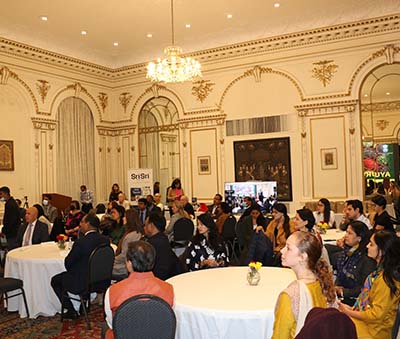 In this regard, he highlighted some data points from the WHO Global Report on Traditional and Complementary Medicine 2019 – number of countries with national policy on traditional and complementary medicine has increased from 25 in 1998 to 98 in 2019 and countries with health insurance cover for traditional and complementary medicine has increased from 37 in 2012 to 45 in 2018. Consul General underlined the vast network of scientific studies being undertaken on Ayurveda in universities in the United States and in research ecosystems across the world including in India.
In this regard, he highlighted some data points from the WHO Global Report on Traditional and Complementary Medicine 2019 – number of countries with national policy on traditional and complementary medicine has increased from 25 in 1998 to 98 in 2019 and countries with health insurance cover for traditional and complementary medicine has increased from 37 in 2012 to 45 in 2018. Consul General underlined the vast network of scientific studies being undertaken on Ayurveda in universities in the United States and in research ecosystems across the world including in India.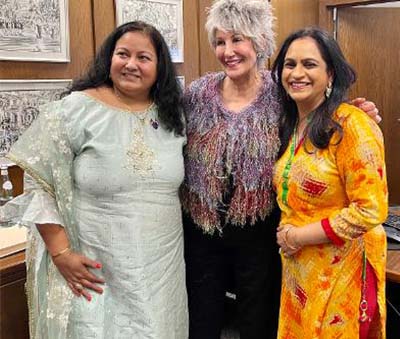 Lion Hina Trivedi spoke about the selfless efforts by Chicago Indo Us lions club in helping families and kids by donating school supplies, backpacks, coat drive and food drive. The club recently helped many patients in India with ventilators as well.
Lion Hina Trivedi spoke about the selfless efforts by Chicago Indo Us lions club in helping families and kids by donating school supplies, backpacks, coat drive and food drive. The club recently helped many patients in India with ventilators as well.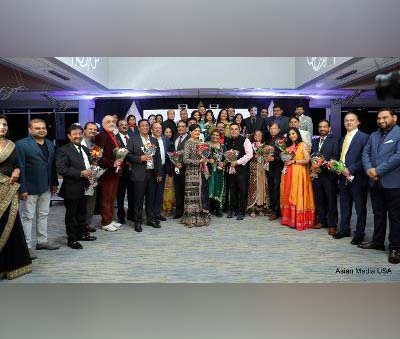 The event featured some very well-known vocalists of Chicagoland Rita Shah, Rajesh Chelam, Jitendra Bulsara, Pratibha Jairath and Mir Ali along with the live orchestra by Orchestra Sa Re Ga Ma led by Hitesh Master Nayak and his team accompanied by Nupur Sound. The musical team kept the guests entertained with a beautiful line up of evergreen melodies. The guests celebrated Sunil Shah’s birthday with a surprise cake cutting ceremony organized by daughter in law Nikki Shah. Mr Shah brought the entire audience on the floor with his excellent singing performance. Sunil and Rita were accompanied by their family and friends who wholeheartedly worked towards the cause behind the evening.
The event featured some very well-known vocalists of Chicagoland Rita Shah, Rajesh Chelam, Jitendra Bulsara, Pratibha Jairath and Mir Ali along with the live orchestra by Orchestra Sa Re Ga Ma led by Hitesh Master Nayak and his team accompanied by Nupur Sound. The musical team kept the guests entertained with a beautiful line up of evergreen melodies. The guests celebrated Sunil Shah’s birthday with a surprise cake cutting ceremony organized by daughter in law Nikki Shah. Mr Shah brought the entire audience on the floor with his excellent singing performance. Sunil and Rita were accompanied by their family and friends who wholeheartedly worked towards the cause behind the evening.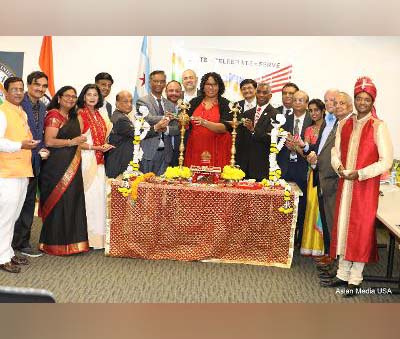 The celebrations encompassed the ceremonious crowning of Chicago’s City Treasurer Hon. Melissa Conyears-Ervin with a silk colorful headgear symbolizing the crowning appreciation from NCAIA for hosting a grand Diwali in the magnificent iconic City Hall building that was led by Event Convener & Vice President Ajeet Singh joined by NCAIA officers: Harish Kolasani, Dr. Suresh Reddy, Vinesh Virani, Neelam Dwivedi Singh, Keerthi Kumar Ravoori, Shekhar Misra, Iftekhar Shareef & Nag Jaiswal. NCAIA National President Harish Kolasani welcomed the guests and outlined the mission of National Council of Asian Indian Associations and how it impacted lives especially in recent times contributing towards the goal of eradication of the pandemic.
The celebrations encompassed the ceremonious crowning of Chicago’s City Treasurer Hon. Melissa Conyears-Ervin with a silk colorful headgear symbolizing the crowning appreciation from NCAIA for hosting a grand Diwali in the magnificent iconic City Hall building that was led by Event Convener & Vice President Ajeet Singh joined by NCAIA officers: Harish Kolasani, Dr. Suresh Reddy, Vinesh Virani, Neelam Dwivedi Singh, Keerthi Kumar Ravoori, Shekhar Misra, Iftekhar Shareef & Nag Jaiswal. NCAIA National President Harish Kolasani welcomed the guests and outlined the mission of National Council of Asian Indian Associations and how it impacted lives especially in recent times contributing towards the goal of eradication of the pandemic.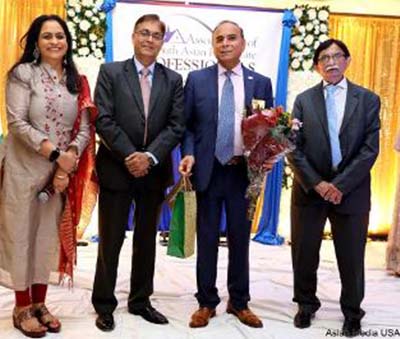 The gala had a variety dance performance by very well-known artists from Chicagoland that included Chicago Kala Kshetra, Sonali Shani and Rewa Shani, Swati Pandey, Aanya and Usha Kabra.
The gala had a variety dance performance by very well-known artists from Chicagoland that included Chicago Kala Kshetra, Sonali Shani and Rewa Shani, Swati Pandey, Aanya and Usha Kabra.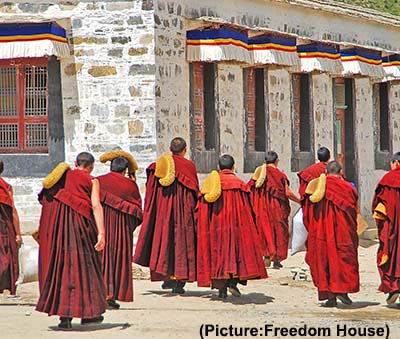 She also said that the Chinese want everything to be melted into the communist style. “So be it Buddhism or anything they want everything to be changed into them.” Speaking over the so-called freedom in Tibet, the Deputy Speaker said: “If there is any freedom in Tibet, why don’t the Chinese let world media go there and see for themselves. “When they shy away from world media that shows that they are hiding something. Why do they have to give all the time white paper on Tibet? This shows that all is not well there,” she said.
She also said that the Chinese want everything to be melted into the communist style. “So be it Buddhism or anything they want everything to be changed into them.” Speaking over the so-called freedom in Tibet, the Deputy Speaker said: “If there is any freedom in Tibet, why don’t the Chinese let world media go there and see for themselves. “When they shy away from world media that shows that they are hiding something. Why do they have to give all the time white paper on Tibet? This shows that all is not well there,” she said.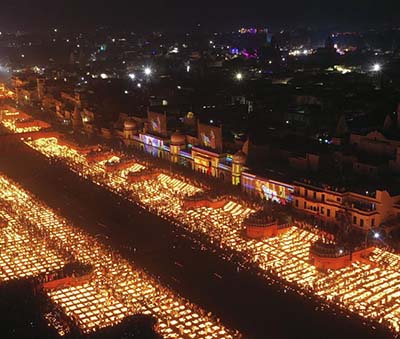 Indians across the country began celebrating Diwali, the Hindu festival of lights, the triumphant return of Lord ram to Ayodhya after rescuing Sita from Sri Lanka. Diwali is typically celebrated by socializing and exchanging gifts with family and friends. Many light oil lamps or candles to symbolize a victory of light over darkness, and fireworks are set off as part of the celebrations.
Indians across the country began celebrating Diwali, the Hindu festival of lights, the triumphant return of Lord ram to Ayodhya after rescuing Sita from Sri Lanka. Diwali is typically celebrated by socializing and exchanging gifts with family and friends. Many light oil lamps or candles to symbolize a victory of light over darkness, and fireworks are set off as part of the celebrations. The President of EventGuru Inc. Neeta Bhasin said ‘We are sharing the message of Deepavali – Knowledge over Ignorance, Light over Darkness, Peace, Love, Unity and Togetherness and inclusion in diversity to the World from the biggest crossroads of the world, Times Square. Even the universe responded in appreciation by keeping the weather conducive to the event despite forecasts of rain throughout the day.’
The President of EventGuru Inc. Neeta Bhasin said ‘We are sharing the message of Deepavali – Knowledge over Ignorance, Light over Darkness, Peace, Love, Unity and Togetherness and inclusion in diversity to the World from the biggest crossroads of the world, Times Square. Even the universe responded in appreciation by keeping the weather conducive to the event despite forecasts of rain throughout the day.’ This was followed by the dignitaries speaking on the Times Square stage which included some of the most affluent people of New York. List of speakers included Consulate General of India in New York, Randhir Jaiswal, New York State Governor Kathleen Courtney Hochul U.S. Senator Charles Ellis “Chuck” Schumer, U.S. Rep. Carolyn Maloney (D-NY), NY State Senator John Liu, Gajendra Suri and Beena Kothari from Samman for All , ShopRite’s Ranjana Choudhry, Thomas Rajan from American Airlines, Harry Singh Bolla of Bolla Oil Corp, Padma Shri Mr. H R Shah – Chairman of TV Asia and other sponsors of the festival.
This was followed by the dignitaries speaking on the Times Square stage which included some of the most affluent people of New York. List of speakers included Consulate General of India in New York, Randhir Jaiswal, New York State Governor Kathleen Courtney Hochul U.S. Senator Charles Ellis “Chuck” Schumer, U.S. Rep. Carolyn Maloney (D-NY), NY State Senator John Liu, Gajendra Suri and Beena Kothari from Samman for All , ShopRite’s Ranjana Choudhry, Thomas Rajan from American Airlines, Harry Singh Bolla of Bolla Oil Corp, Padma Shri Mr. H R Shah – Chairman of TV Asia and other sponsors of the festival. NY State Senator, John Liu was very excited to see the huge crowd at Times Square ‘It is great to see everybody in person. No better place to celebrate Diwali than the crossroads of the world right here in Times Square, NY City. With Neeta’s advocacy and esteem journalism and many others, in NYC a long time ago we were able to make a parking holiday, you do not change the car from one side of the street to another’.
NY State Senator, John Liu was very excited to see the huge crowd at Times Square ‘It is great to see everybody in person. No better place to celebrate Diwali than the crossroads of the world right here in Times Square, NY City. With Neeta’s advocacy and esteem journalism and many others, in NYC a long time ago we were able to make a parking holiday, you do not change the car from one side of the street to another’. This year for the first time, the
This year for the first time, the 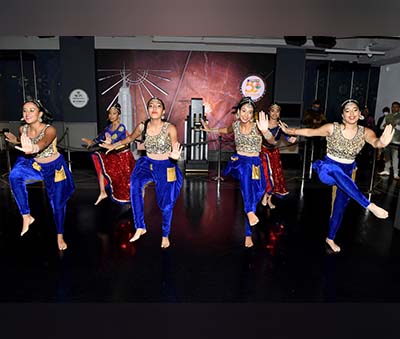 FIA Chairman Ankur Vaidya, President Elect Kenny Desai, Past President Alok Kumar and Executive members Parveen Bansal and Saurin Parikh participated in the event as well. In follow up to a spectacular dance performance by the students of Aum Dance Creations the Empire State Building ceremonial lighting was turned on together by Jay Sean, Thara Natalie and Hon. Consul General Jaiswal. H.E. Randhir Jaiswal conveyed Diwali wishes and thanked the American community for accepting and embracing diversity.
FIA Chairman Ankur Vaidya, President Elect Kenny Desai, Past President Alok Kumar and Executive members Parveen Bansal and Saurin Parikh participated in the event as well. In follow up to a spectacular dance performance by the students of Aum Dance Creations the Empire State Building ceremonial lighting was turned on together by Jay Sean, Thara Natalie and Hon. Consul General Jaiswal. H.E. Randhir Jaiswal conveyed Diwali wishes and thanked the American community for accepting and embracing diversity. The FIA believes that such gestures by ESRT help in spreading the ancient Indian philosophy of ‘Vasudeva Kutumbakam’ (the world is one family) and also demonstrates a great harmony in spirit and deeds between people of the world’s largest and oldest democracies, the organization stated in a press release. Despite the challenges and changes due to the Covid-19 pandemic, FIA has not deterred from its goal of serving the community, it said.
The FIA believes that such gestures by ESRT help in spreading the ancient Indian philosophy of ‘Vasudeva Kutumbakam’ (the world is one family) and also demonstrates a great harmony in spirit and deeds between people of the world’s largest and oldest democracies, the organization stated in a press release. Despite the challenges and changes due to the Covid-19 pandemic, FIA has not deterred from its goal of serving the community, it said. The events included deepmala as well as katha and kirtan by Bhai Rajinder Singh and Jatha, Bhai Parminderjit Singh and bhai Inderjit Singh Khalsa.
The events included deepmala as well as katha and kirtan by Bhai Rajinder Singh and Jatha, Bhai Parminderjit Singh and bhai Inderjit Singh Khalsa. Sikh Religious Society, a non-profit organization, in Palatine, Illinois was formed in 1974 and its first formal Prakash Divas (the ceremonial acceptance of Guru GRANTH Sahib {Sikh’s holy scripture/book} at this new place of worship was celebrated in 1975. The organization focuses on Sikh religious services, Punjabi language/ Kirtan classes. Another focus of this society is on the community service, charity and other Non Profit endeavors to promote the Punjabi culture and heritage.
Sikh Religious Society, a non-profit organization, in Palatine, Illinois was formed in 1974 and its first formal Prakash Divas (the ceremonial acceptance of Guru GRANTH Sahib {Sikh’s holy scripture/book} at this new place of worship was celebrated in 1975. The organization focuses on Sikh religious services, Punjabi language/ Kirtan classes. Another focus of this society is on the community service, charity and other Non Profit endeavors to promote the Punjabi culture and heritage.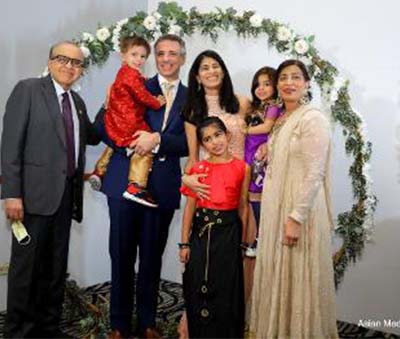 Another board member Nand Balani elaborated on the initiative called, Alliance of Global Sindhi Association that connects Sindhis all over to the world. The three aims of the alliance focus on matrimonial services, romanized script for sindhi language, and a global sindhi directory.
Another board member Nand Balani elaborated on the initiative called, Alliance of Global Sindhi Association that connects Sindhis all over to the world. The three aims of the alliance focus on matrimonial services, romanized script for sindhi language, and a global sindhi directory.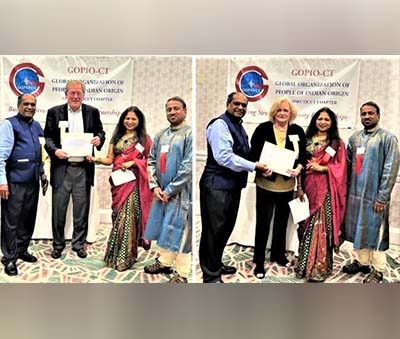 Future 5 helps underprivileged students in the Stamford High School system. Future 5 envisions a world where all students can be part of a vibrant and supportive community and access the people and resources they need for college, career and life success.
Future 5 helps underprivileged students in the Stamford High School system. Future 5 envisions a world where all students can be part of a vibrant and supportive community and access the people and resources they need for college, career and life success. The event was attended in-person by several dignitaries, including United States Sen. Charles E. Schumer, U.S. Rep. Carolyn Maloney, India’s Consul General in New York Randhir Jaiswal, New York State Sen. John Liu, Padma Shri Sudhir Parikh, chairman of Parikh Worldwide Media and ITV Gold, H.R. Shah of TV Asia, representatives of the Indian Police Officers Society from the New York Police Department, and several other special guests who spoke on stage about the meaning of Diwali and the joy of celebrating it after Covid.
The event was attended in-person by several dignitaries, including United States Sen. Charles E. Schumer, U.S. Rep. Carolyn Maloney, India’s Consul General in New York Randhir Jaiswal, New York State Sen. John Liu, Padma Shri Sudhir Parikh, chairman of Parikh Worldwide Media and ITV Gold, H.R. Shah of TV Asia, representatives of the Indian Police Officers Society from the New York Police Department, and several other special guests who spoke on stage about the meaning of Diwali and the joy of celebrating it after Covid. This year in contrast to last year, Liu said, the number of Diwali celebrations has risen, “in our schools, in our mandirs, and City Hall,” he said, a tradition he started when he was a New York City Councilor. “There’s no better place to celebrate Diwali than at the ‘Crossroads of the World’, right here in Times Square, New York City. Because this is such an important holiday for billions of people around the world symbolizing the victory of good over evil, light over darkness …”
This year in contrast to last year, Liu said, the number of Diwali celebrations has risen, “in our schools, in our mandirs, and City Hall,” he said, a tradition he started when he was a New York City Councilor. “There’s no better place to celebrate Diwali than at the ‘Crossroads of the World’, right here in Times Square, New York City. Because this is such an important holiday for billions of people around the world symbolizing the victory of good over evil, light over darkness …”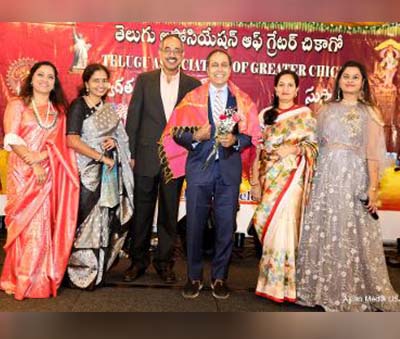 The event was described as a grand success with an overwhelming response from the Telugu community with 2000+ guests in attendance over 2 days. Multiple guests from Community, National and Local Telugu organizations, long time Sponsors PMSI Ashok Lakshmanan, NYLife Krishna Rangaraju joined along with Chief Guest U.S Congressman Raja Krishnamoorthy, Dr. Sreenivas Reddy, a member of the National council on White House History and Indian Consulate General’s office represented by Consul Gopal Bhagath.
The event was described as a grand success with an overwhelming response from the Telugu community with 2000+ guests in attendance over 2 days. Multiple guests from Community, National and Local Telugu organizations, long time Sponsors PMSI Ashok Lakshmanan, NYLife Krishna Rangaraju joined along with Chief Guest U.S Congressman Raja Krishnamoorthy, Dr. Sreenivas Reddy, a member of the National council on White House History and Indian Consulate General’s office represented by Consul Gopal Bhagath. As part of the 50th year celebrations second day “Joruga Husharuga – Dasara and Diwali celebrations”, 250+ participants including kids, youth, couples and senior members of TAGC entertained guests with their performances. Event brought a true festive atmosphere where all the seniors, youth and kids came together under one roof to celebrate the 50-year history of the Telugu community in America and the importance of perseverance.
As part of the 50th year celebrations second day “Joruga Husharuga – Dasara and Diwali celebrations”, 250+ participants including kids, youth, couples and senior members of TAGC entertained guests with their performances. Event brought a true festive atmosphere where all the seniors, youth and kids came together under one roof to celebrate the 50-year history of the Telugu community in America and the importance of perseverance. “But one of the things that concern me most about the last few years is another type of pandemic, the invisible pandemic that we are in the midst of. That’s a pandemic of polarization where it feels increasingly people have turned against each other, where they have demonized one another, called each other evil and treated each other as so. That’s a particular kind of darkness,” he said.
“But one of the things that concern me most about the last few years is another type of pandemic, the invisible pandemic that we are in the midst of. That’s a pandemic of polarization where it feels increasingly people have turned against each other, where they have demonized one another, called each other evil and treated each other as so. That’s a particular kind of darkness,” he said. The event was attended by Congressmen Raja Krishnamoorthy, Illinois; Tim Ryan, Ohio; Greg Stanton, Arizona; Danny Davis, Illinois; Mike Quigley, Illinois; and, Audrey Kitawaga, Ambassador of Religions for Peace. Ambassador Sandhu emphasized critical points regarding the element of solidarity, the unity and partnership between the two nations, the importance of science and spiritual and extending happiness and kindness to all in these unprecedented times.
The event was attended by Congressmen Raja Krishnamoorthy, Illinois; Tim Ryan, Ohio; Greg Stanton, Arizona; Danny Davis, Illinois; Mike Quigley, Illinois; and, Audrey Kitawaga, Ambassador of Religions for Peace. Ambassador Sandhu emphasized critical points regarding the element of solidarity, the unity and partnership between the two nations, the importance of science and spiritual and extending happiness and kindness to all in these unprecedented times. The virtual conference showcased the diversity of views within the Hindu world, feature friends of the Hindu community, and address a troubling trend of anti-Hindu sentiment (Hindudvesha or Hinduphobia) which has more recently plagued the Hindu diaspora in the United States, Canada and other parts of the world.
The virtual conference showcased the diversity of views within the Hindu world, feature friends of the Hindu community, and address a troubling trend of anti-Hindu sentiment (Hindudvesha or Hinduphobia) which has more recently plagued the Hindu diaspora in the United States, Canada and other parts of the world. The event was attended by Media Houses, Performers and the Sponsors of Diwali at Times Square. The program started with Ganesh Pooja followed by Diya Lighting Ceremony and Presentation by Neeta Bhasin, Founder of Diwali at Times Square where she shared the details of the upcoming festival. Sponsors like Shoprite and American Airlines spoke of the significance and importance of cultural event as big as Diwali at Times Square and its impact on the community.
The event was attended by Media Houses, Performers and the Sponsors of Diwali at Times Square. The program started with Ganesh Pooja followed by Diya Lighting Ceremony and Presentation by Neeta Bhasin, Founder of Diwali at Times Square where she shared the details of the upcoming festival. Sponsors like Shoprite and American Airlines spoke of the significance and importance of cultural event as big as Diwali at Times Square and its impact on the community. The latter is found mostly in Eastern Himalayas and China and used in naturopathy and certain food preparations like meat dishes, stews and barbecue sauces, owing to its bolder flavor. And, it is now one of the much soiught after spices India exports around the world.
The latter is found mostly in Eastern Himalayas and China and used in naturopathy and certain food preparations like meat dishes, stews and barbecue sauces, owing to its bolder flavor. And, it is now one of the much soiught after spices India exports around the world. The two leaders discussed with Pope Francis issues covering a range of areas of interest, including COVID-19, general global perspectives and maintaining peace and tranquility. After the meeting, Modi tweeted, with pictures of him embracing the Pope, “Had a very warm meeting with Pope Francis. I had the opportunity to discuss a wide range of issues with him and also invited him to visit India.”
The two leaders discussed with Pope Francis issues covering a range of areas of interest, including COVID-19, general global perspectives and maintaining peace and tranquility. After the meeting, Modi tweeted, with pictures of him embracing the Pope, “Had a very warm meeting with Pope Francis. I had the opportunity to discuss a wide range of issues with him and also invited him to visit India.” Pope Francis and the Prime Minister then exchanged gifts. Modi gave the Pope a silver candlestick and a copy of The Climate Climb. Pope Francis gave Modi a bronze plaque with the inscription “the desert will become a garden,” and copies of the pope’s writings, including his encyclicals “Laudato Si’” and “Fratelli Tutti,” as well as the “
Pope Francis and the Prime Minister then exchanged gifts. Modi gave the Pope a silver candlestick and a copy of The Climate Climb. Pope Francis gave Modi a bronze plaque with the inscription “the desert will become a garden,” and copies of the pope’s writings, including his encyclicals “Laudato Si’” and “Fratelli Tutti,” as well as the “ “The meeting should not be seen merely as the one between two country heads, rather it was the head of the largest democracy and an ancient culture of the world meeting the head of the largest religious community in the world. This brings in hope for enhancing human fraternity and caring for the poor, because that’s what Christianity stands for. It would bring in positive efforts in India for a mutual trust and collaboration between people of different religious groups. It would also contribute to the very need for dialogues. We are very delighted that the Prime Minister has opened ways for a Papal visit to India,” the Cardinal Cleemis told the media.
“The meeting should not be seen merely as the one between two country heads, rather it was the head of the largest democracy and an ancient culture of the world meeting the head of the largest religious community in the world. This brings in hope for enhancing human fraternity and caring for the poor, because that’s what Christianity stands for. It would bring in positive efforts in India for a mutual trust and collaboration between people of different religious groups. It would also contribute to the very need for dialogues. We are very delighted that the Prime Minister has opened ways for a Papal visit to India,” the Cardinal Cleemis told the media. The event was organized by Manoj Rathod and Tanmay Patel featured two very well-known versatile vocalists Badal Parmar and Bharti Desai who kept the atmosphere upbeat and devotional and had everyone dancing throughout the entire event. Badal Parmar performed traditional Kathiawadi style garba as well as popular Hindi songs. His style of performance reflects an immense amount of Gujarati garba as well as modern beats. This unique style of singing is what makes him such a versatile performer. Garba Queen of United State of America Desai who is an award-winning singer in Chicago enthralled the audience with her charming personality. She continued amazing Garbas in Two Taali. In Raas everybody enjoyed Disco Dandia, Sanedo, Amu Kaka Bapa Na, Bhai-Bhai, Hitch..
The event was organized by Manoj Rathod and Tanmay Patel featured two very well-known versatile vocalists Badal Parmar and Bharti Desai who kept the atmosphere upbeat and devotional and had everyone dancing throughout the entire event. Badal Parmar performed traditional Kathiawadi style garba as well as popular Hindi songs. His style of performance reflects an immense amount of Gujarati garba as well as modern beats. This unique style of singing is what makes him such a versatile performer. Garba Queen of United State of America Desai who is an award-winning singer in Chicago enthralled the audience with her charming personality. She continued amazing Garbas in Two Taali. In Raas everybody enjoyed Disco Dandia, Sanedo, Amu Kaka Bapa Na, Bhai-Bhai, Hitch.. “Navaratri Garba is very special as it honors Shakti in very rhythmic ways. We all love the whole atmosphere of colors, the clothes and of course, the music and then there is always the fun of dressing traditionally. Western dresses are replaced by Lengha-Choli, matching jewelry and foot wear”, said one of the participants. The evening was followed by traditional garba music and concluded in the wee hours of morning highlighted by devotional Arti of Mataji.
“Navaratri Garba is very special as it honors Shakti in very rhythmic ways. We all love the whole atmosphere of colors, the clothes and of course, the music and then there is always the fun of dressing traditionally. Western dresses are replaced by Lengha-Choli, matching jewelry and foot wear”, said one of the participants. The evening was followed by traditional garba music and concluded in the wee hours of morning highlighted by devotional Arti of Mataji.